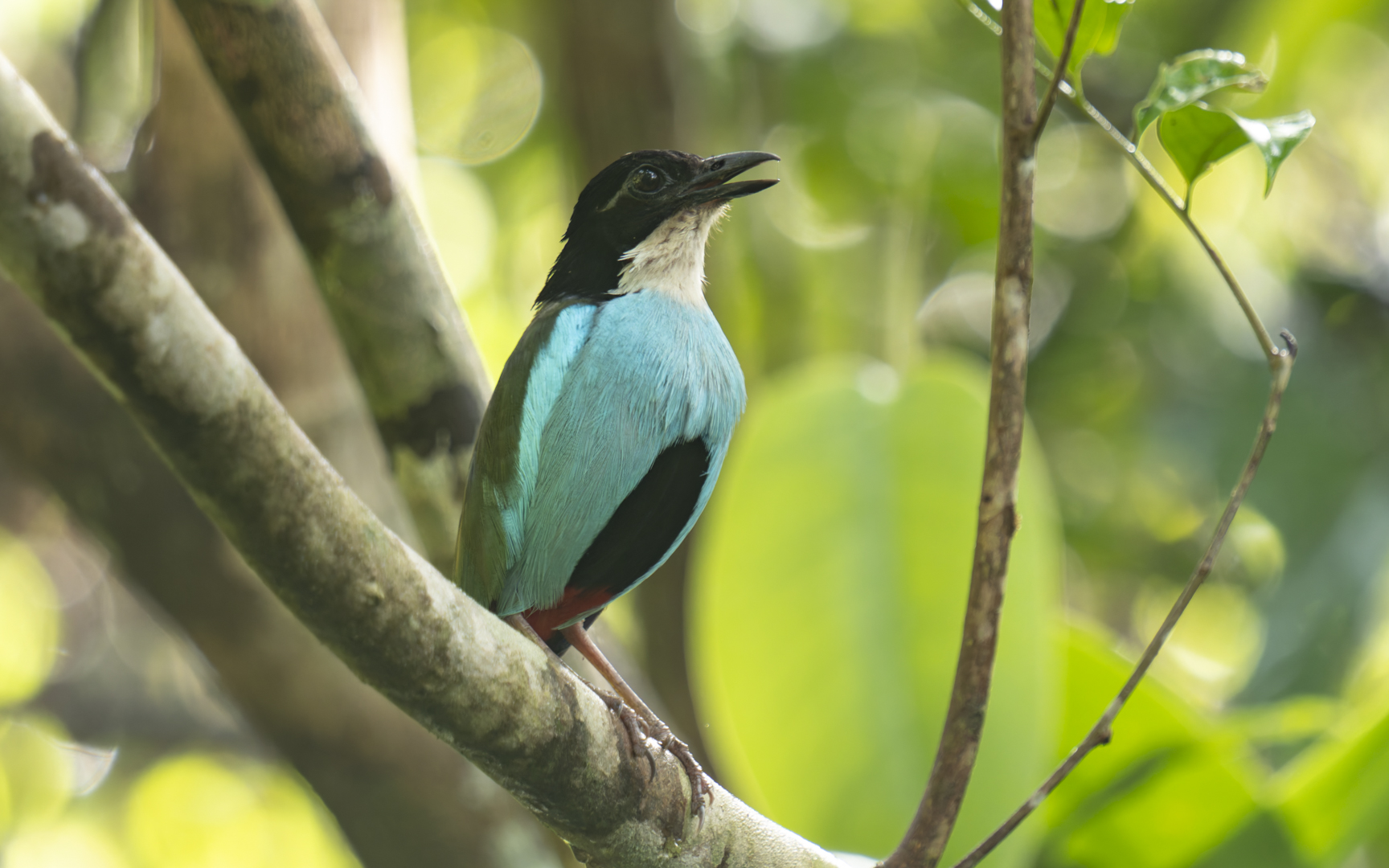Scientific Name: Pitta steeriiEnglish Name: Azure-breasted PittaObserved in: PICOPLocal Status: EndemicObserved Timing: Jun-24 今回の探鳥の最大の目的でした。ソライロヤイロチョウ。石灰岩の森に生息しており、体色はその影響を受けているのでしょうか。。他のヤイロチョウには見られない光り輝く水色をしています。素晴らしいです。出てきてくれた鳥たちとガイドに感謝するばかりです。
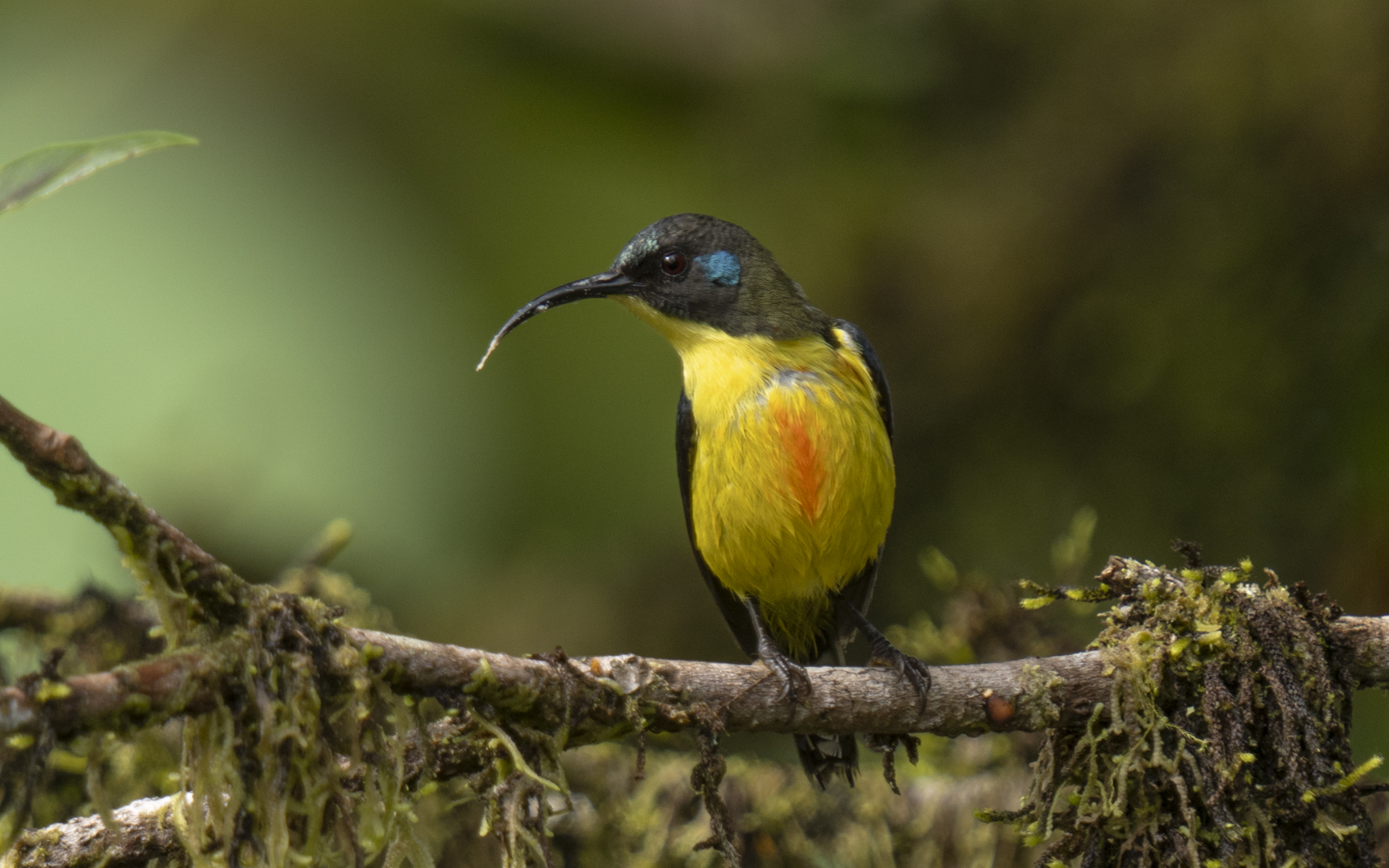
Aethopyga linaraborae
Scientific Name: Aethopyga linaraboraeEnglish Name: Lina’s SunbirdObserved in: ComValLocal Status: Endemic in MindanaoObserved Timing: Jun-24 今回の探鳥で最も良い意味で不意を突かれたのが当種でした。なんて美しいタイヨウチョウなんでしょう! 海外の探鳥に出かける際には、事前予習をするためにガイドブックを買いますが、それにも掲載されておらず、知る人ぞ知る隠された宝石のような鳥です。準絶滅危惧種でミンダナオのごく限られた地域にのみ生息しています。 森林破壊の進む現地ですが、どうかこの先も残ってくれることを切に願うのみです。
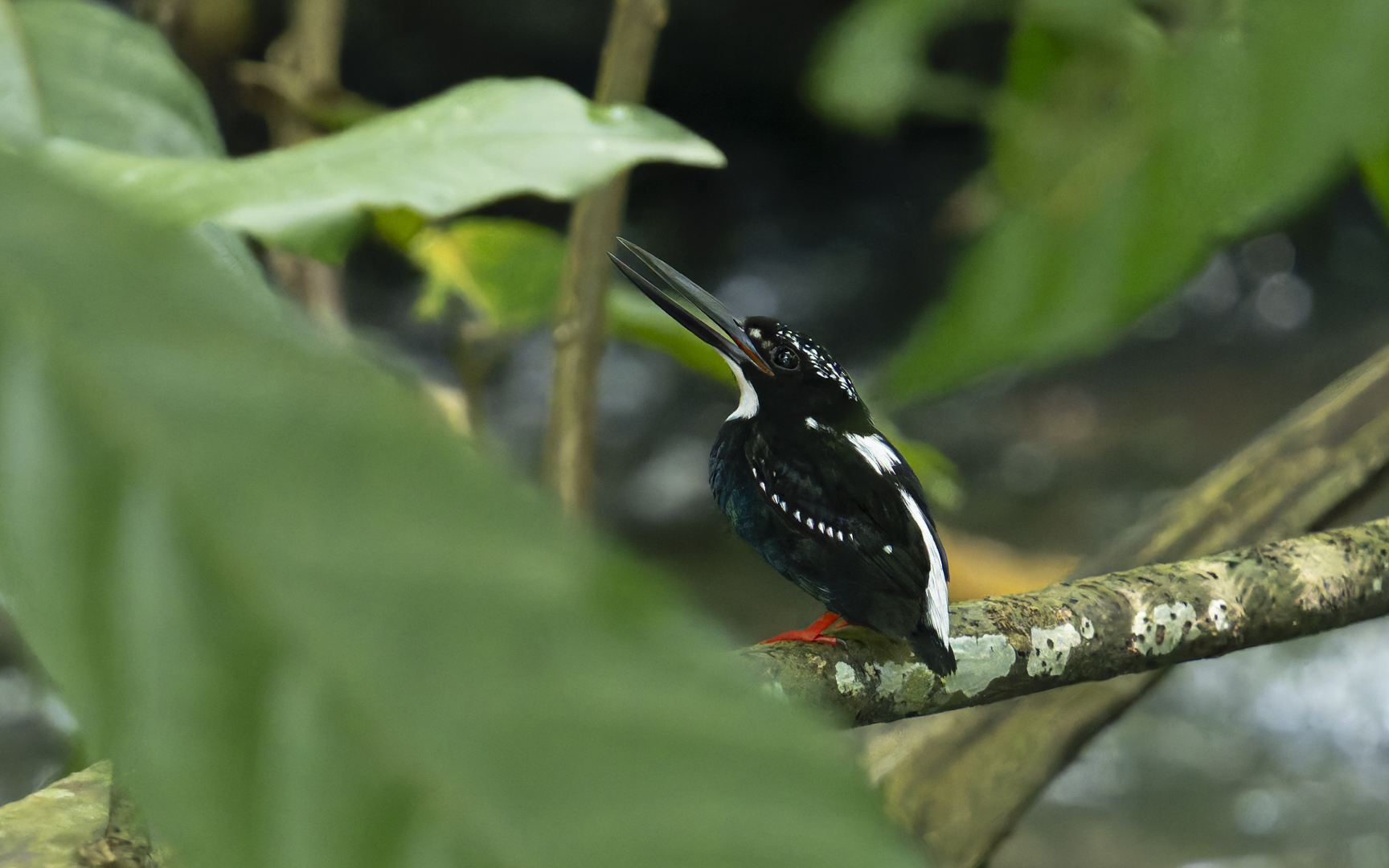
Ceyx argentatus – セジロカワセミ
Scientific Name: Ceyx argentatusEnglish Name: Southern Silvery-KingfisherObserved in: PICOP, Davao CityLocal Status: Endemic in MindanaoObserved Timing: Jun-24 今回最も見たかった鳥の1つが当種セジロカワセミでした。小さい体に不釣り合いな長いクチバシと、赤い足がなんとも可愛い。準絶滅危惧種です。PICOPでは川の対岸に餌渡しをするペアも見ることができましたが、如何せん遠く、いい写真にはなりませんでした。この写真は分け合って延長滞在することとなったDavao近郊で撮影したものです。鳴き声はするが姿を見つけられず、諦めかけていたところ、妻のファインプレーが炸裂しました。
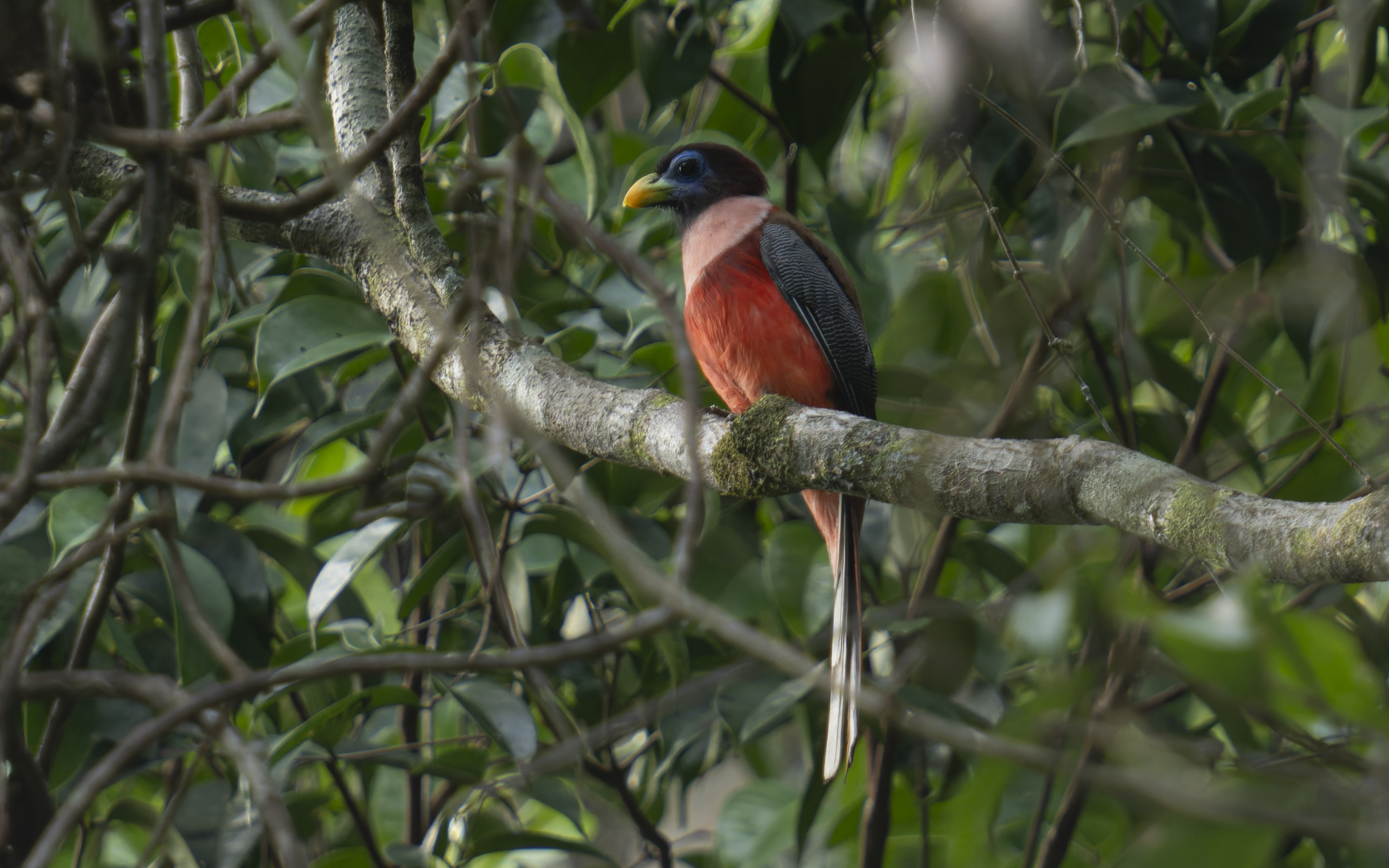
Harpactes ardens – バラムネキヌバネドリ
Scientific Name: Harpactes ardensEnglish Name: Philippine TrogonObserved in: PICOPLocal Status: EndemicObserved Timing: Jun-24 PICOPでの疲れがたまってきた、切り上げ間際のガイドのファインプレーでした。光の差し込みづらい木々の間に留まっていたのは、すごい色の取り合わせをした当種です。ピンク色のエリマキをして、どぎつい青紫のアイシャドーに黄色いクチバシ。そして赤い腹部。自然の神秘です。
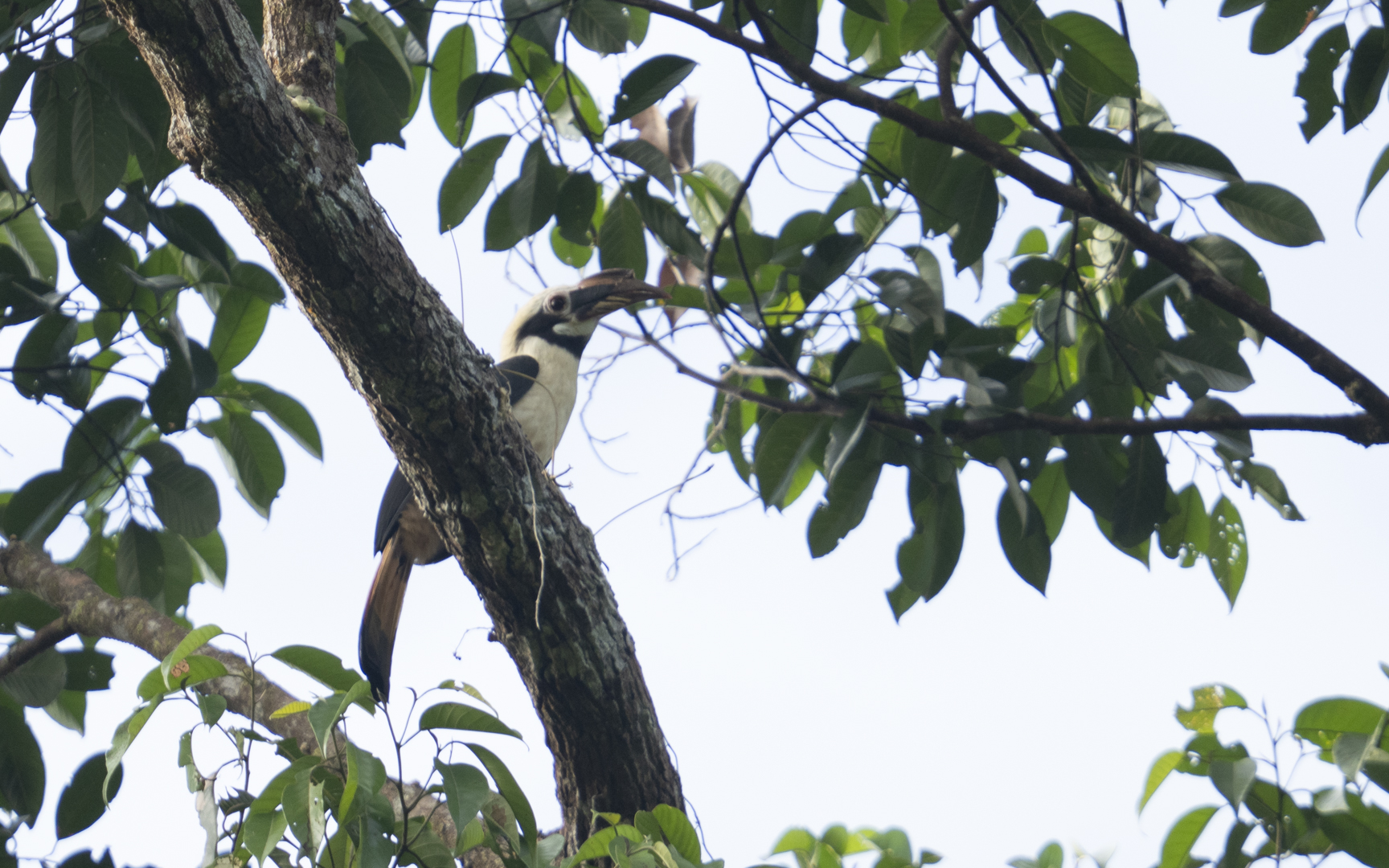
Penelopides affinis – ミンダナオカオグロサイチョウ
Scientific Name: Penelopides affinisEnglish Name: Mindanao HornbillObserved in: PICOPLocal Status: EndemicObserved Timing: Jun-24 ミンダナオ固有種のサイチョウです。写真1枚目がオス、2枚目がメスになります。PICOPでの探鳥中、他のサイチョウも見かけましたが、木々に覆われた狭い上空を通り過ぎていくので目視するのがやっとでした。
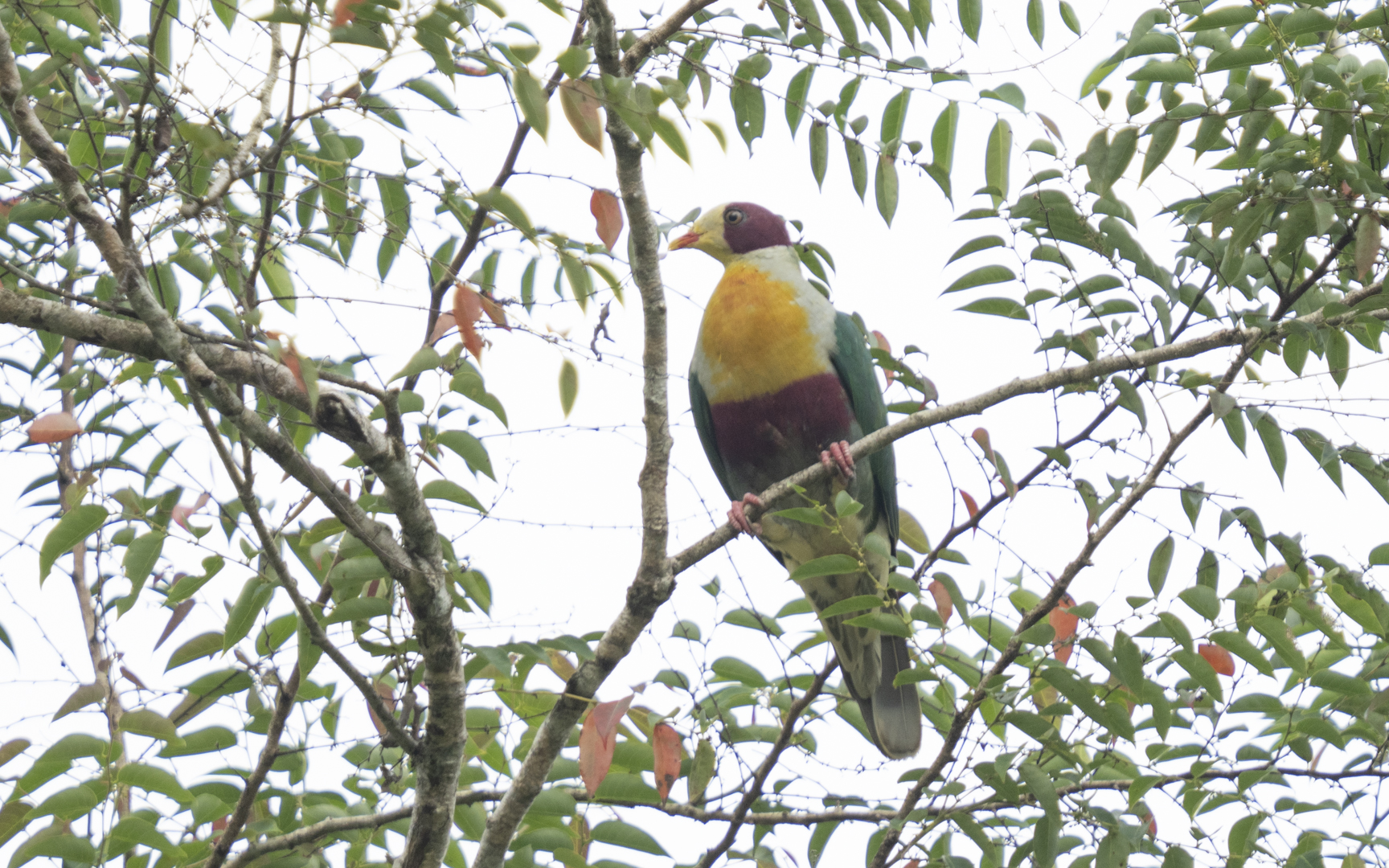
Ptilinopus occipitalis – ホオアカヒメアオバト
Scientific Name: Ptilinopus occipitalisEnglish Name: Yellow-breasted Fruit-DoveObserved in: PICOPLocal Status: EndemicObserved Timing: Jun-24 フィリピン国内では最も一般的なPtilinopus属の鳥です。Fruit-doveはどの種も独特のカラーリングが楽しく、暑さで疲れ果てていても、一気にテンションを高めてくれます。
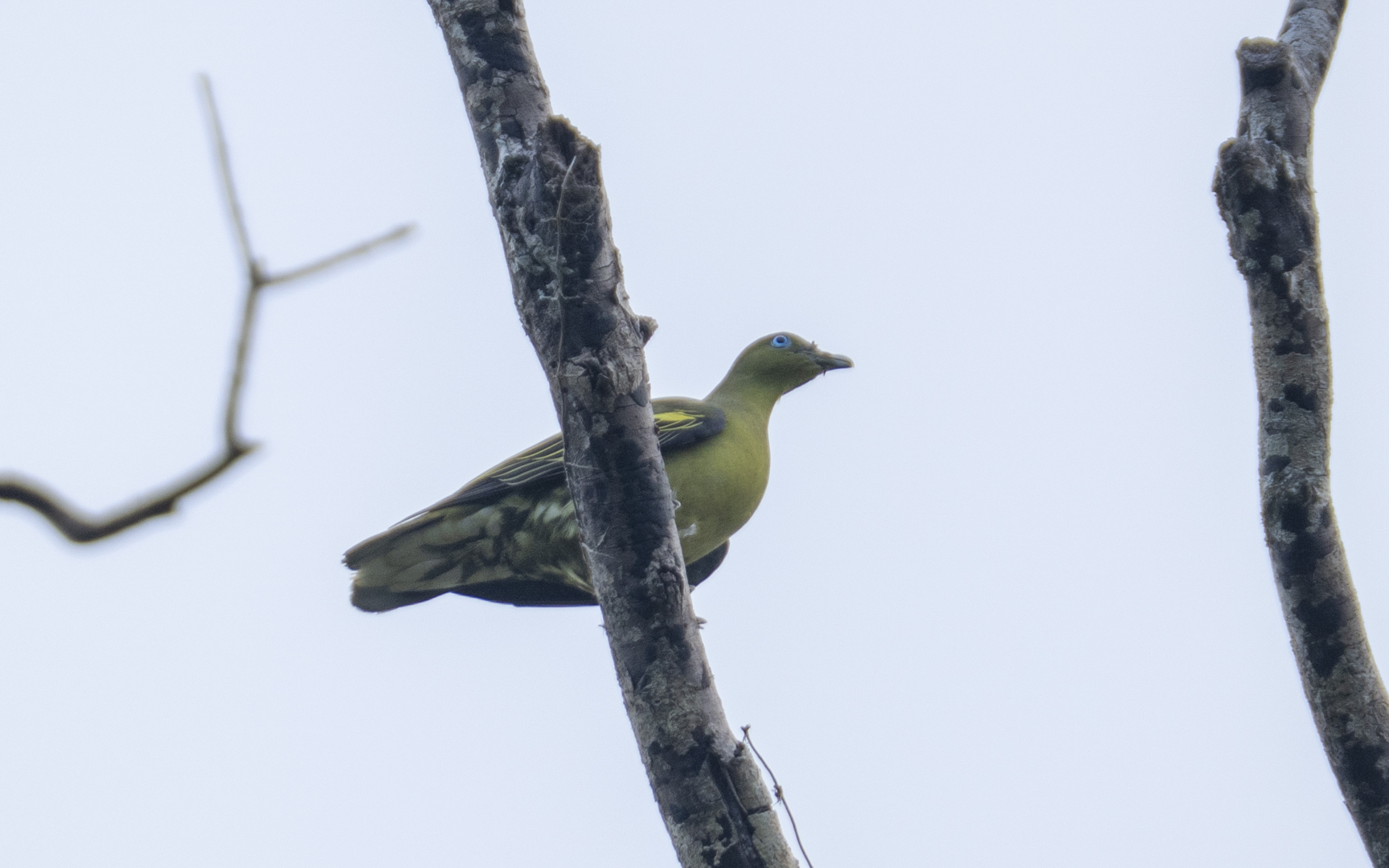
Treron axillaris – フィリピンアオバト
Scientific Name: Treron axillarisEnglish Name: Philippine Green-PigeonObserved in: PICOPLocal Status: EndemicObserved Timing: Jun-24 写真はメスですが、オスは羽の上部が赤茶色をしている美しいハトです。
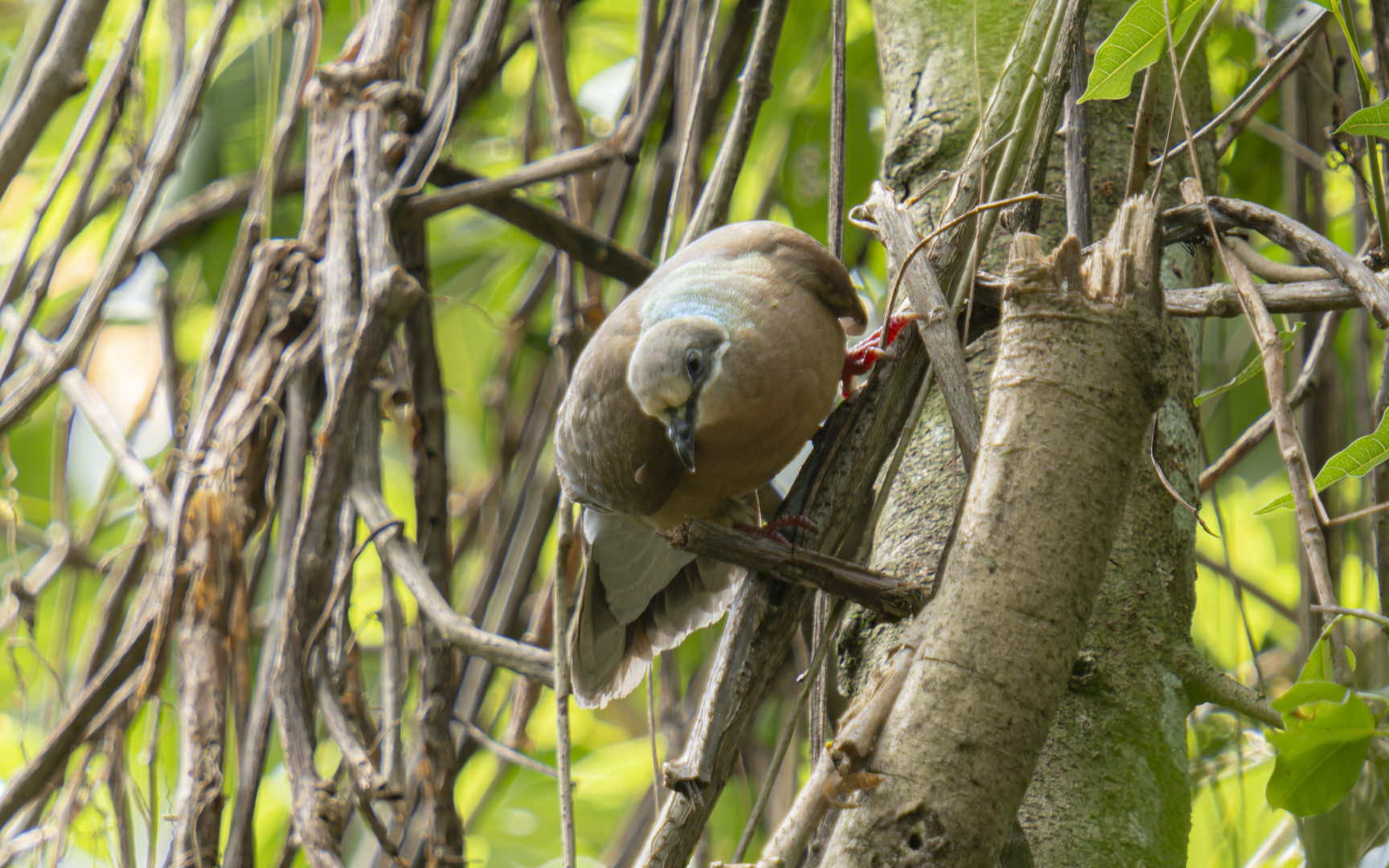
Phapitreron leucotis – テリアオバト
Scientific Name: Phapitreron leucotisEnglish Name: White-eared Brown-DoveObserved in: PICOP, Davao CityLocal Status: EndemicObserved Timing: Jun-24 良く似た種にオオテリアオバト Phapitreron amethystinus (Amethyst Brown-Dove)がおり、こちらはより体調が大きく、より太いクチバシを持っています。写真の2枚目は、そのクチバシの特徴から、もしかしたらamethystinusかもしれません。
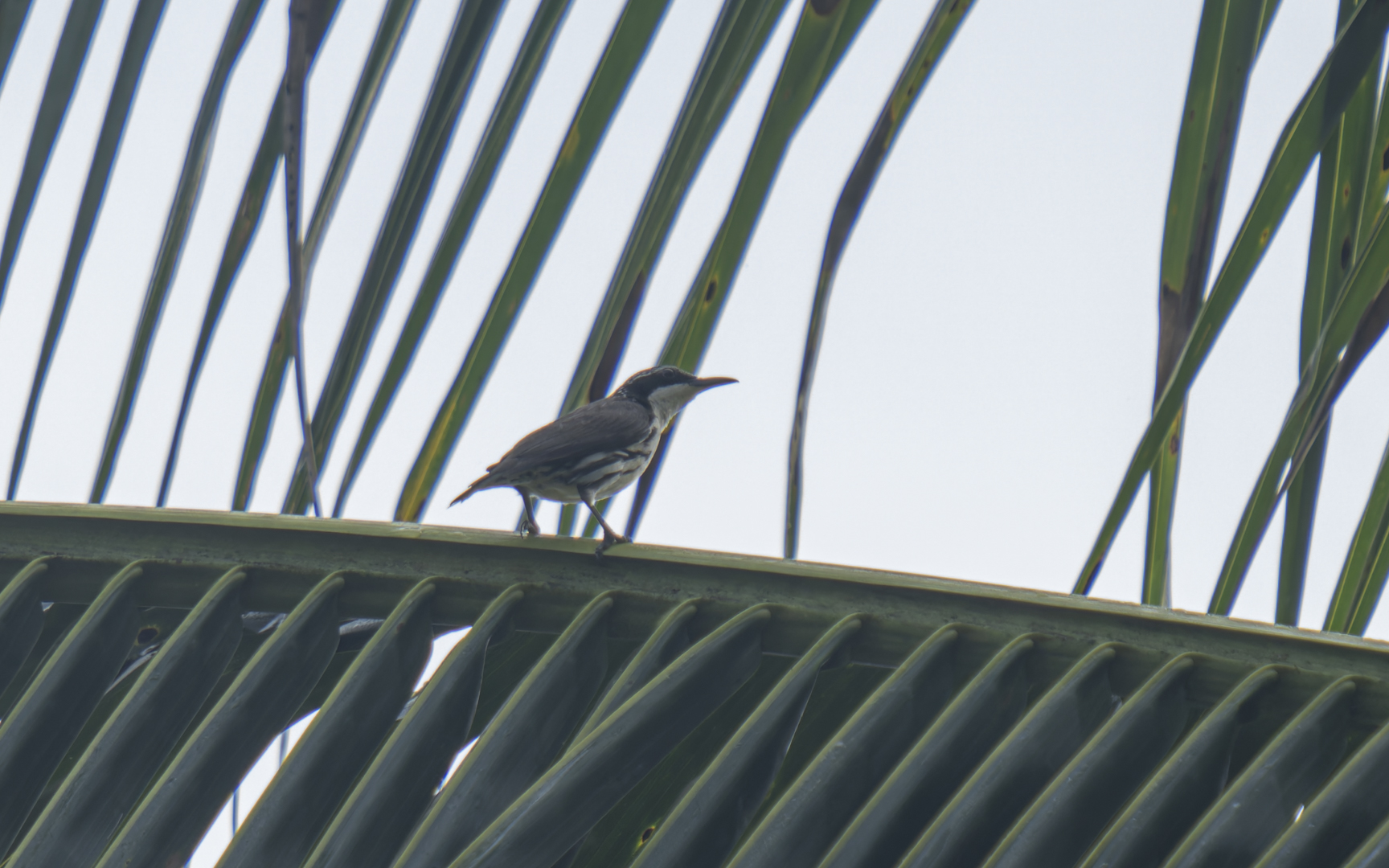
Rhabdornis mystacalis – キバシリモドキ
Scientific Name: Rhabdornis mystacalisEnglish Name: Stripe-sided RhabdornisObserved in: PICOPLocal Status: EndemicObserved Timing: Jun-24 キバシリモドキ属 (Rhabdornis) はフィリピン固有であり渡りをしません。ムクドリ科 Sturnidae に属しますが、他の当科の種とは異なった見た目をしています。当種キバシリモドキは当属4種をうちの1種であり、フィリピン全域に生息します。 なお、ミンダナオにはムジキバシリモドキ (Rhabdornis inornatus, Stripe-breasted Rhabdornis) も生息していますが、inornatusは喉元まで模様が入っていることで当種mystacalisとの見分けがつきます。
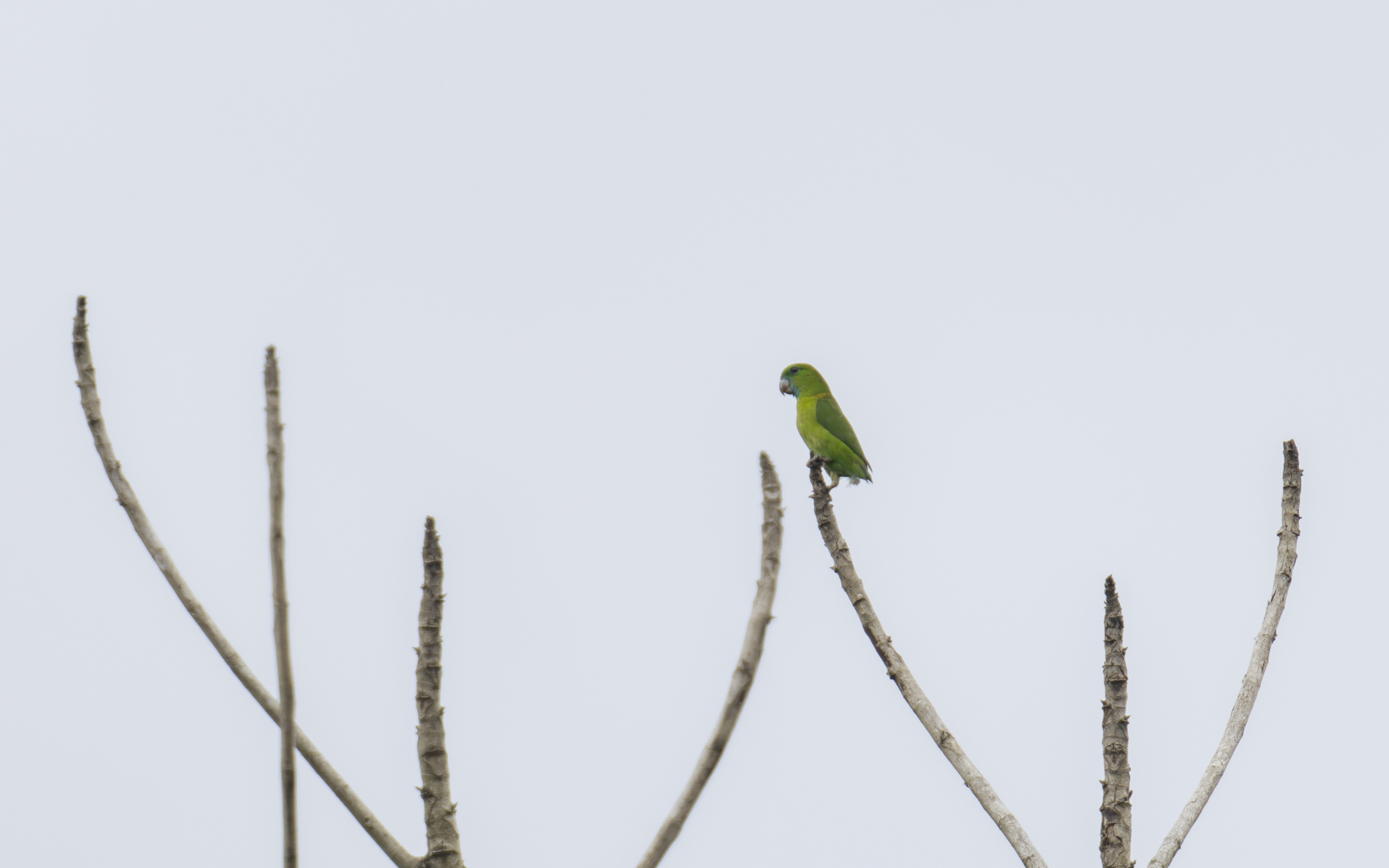
バンジロウインコ
Scientific Name: Bolbopsittacus lunulatusEnglish Name: GuaiaberoObserved in: PICOPLocal Status: EndemicObserved Timing: Jun-24 記録用として掲載します。一般種なので撮り直しの機会はあるでしょう。。バンジロウってなんなんですかね。英名はグァバを好んで食べる習性に由来しているようです。Bolbopsittacus属の唯一の種です。
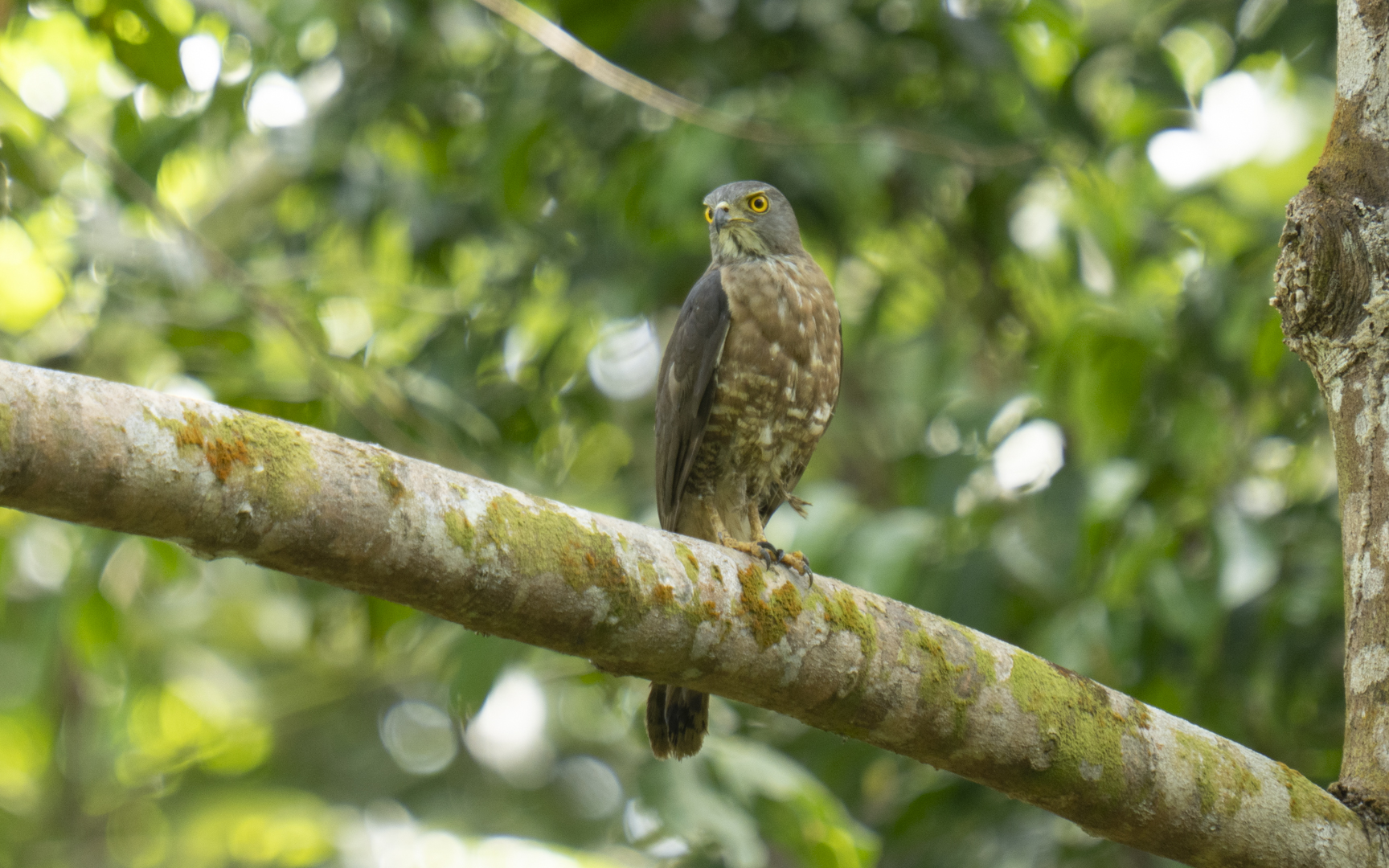
Tachyspiza virgata – ミナミツミ
Scientific Name: Tachyspiza virgataEnglish Name: BesraObserved in: PICOPLocal Status: EndemicObserved Timing: Jun-24 東洋区の全域で見られる種で、シンガポールでもごくまれに観察されています。猛禽類の生息範囲は一般的に広いので、固有種とはなりにくいと思いますが、それでもフィリピンには数種がおり、最も有名なのはフィリピンワシです。野生の個体を見てみたいものです。
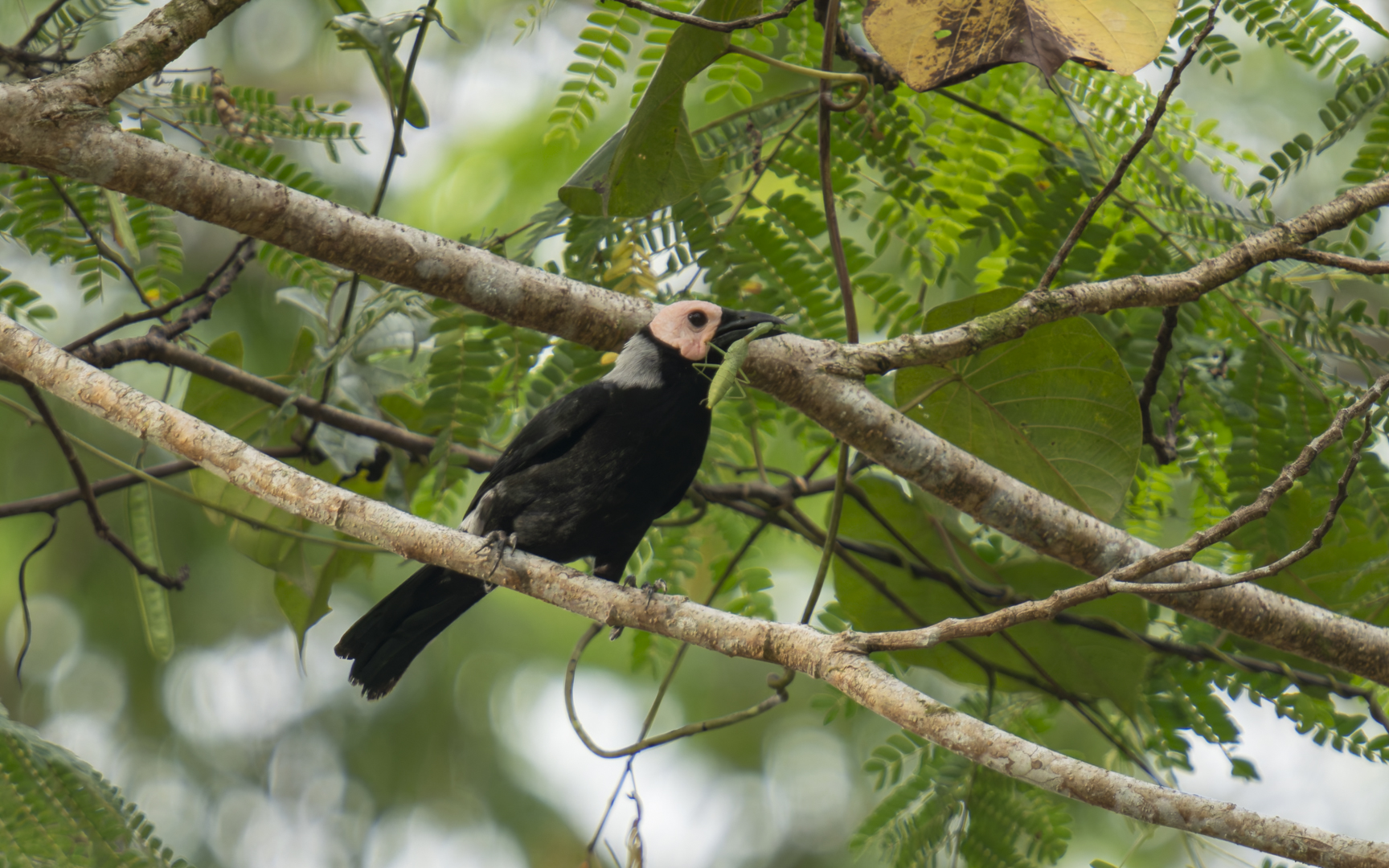
Sarcops calvus – メガネムクドリ
Scientific Name: Sarcops calvusEnglish Name: ColetoObserved in: PICOPLocal Status: EndemicObserved Timing: Jun-24 肌色の頭部が面白く、独特の風貌をしています。背の高い木の上におり、なかなか下までは降りてきてくれませんでした。
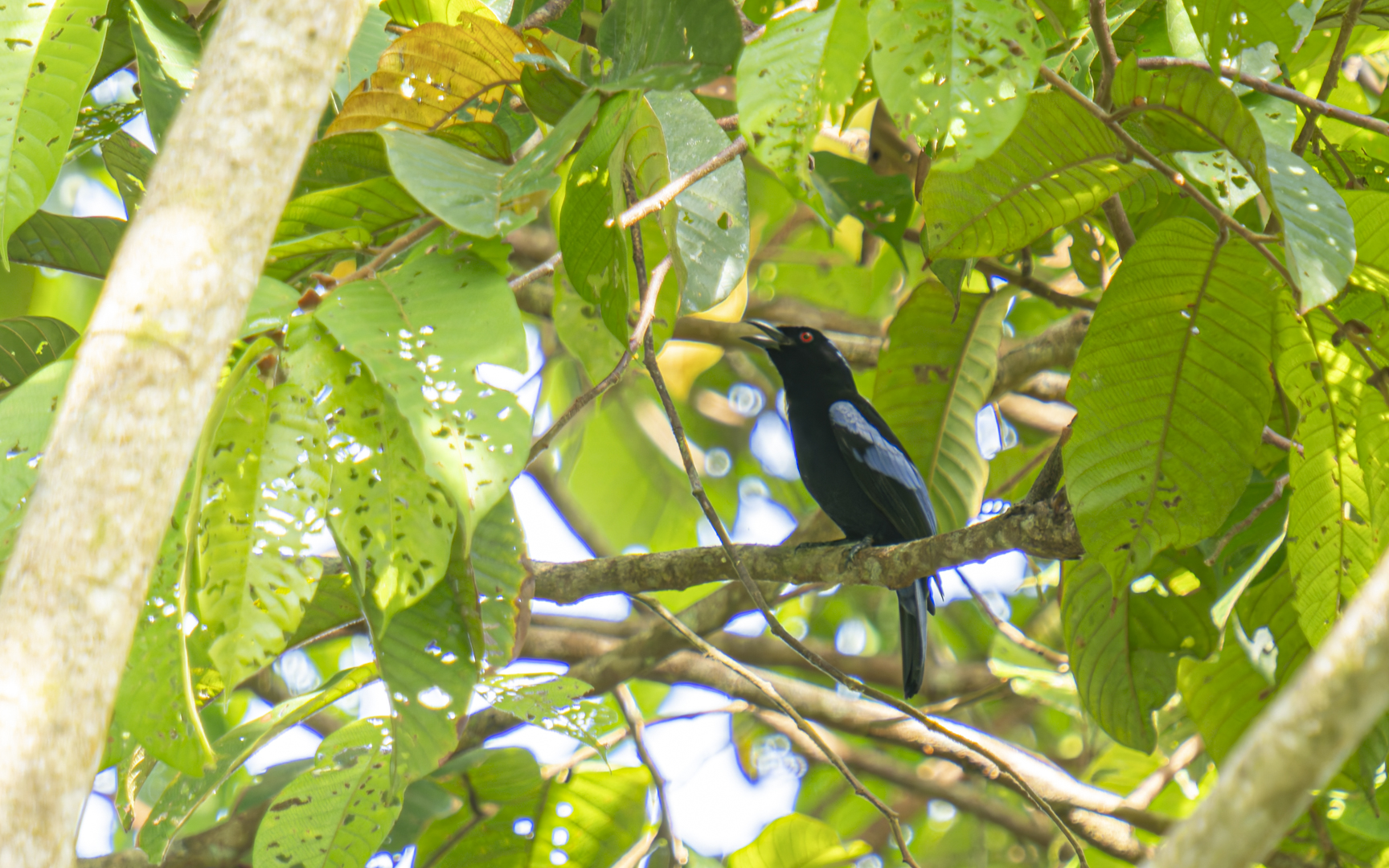
Irena cyanogastra – スミレコノハドリ
Scientific Name: Irena cyanogastraEnglish Name: Philippine Fairy-bluebirdObserved in: PICOPLocal Status: EndemicObserved Timing: Jun-24 フィリピンに広く分布しますが個体数は少ないようです。遠くの木々の間を行き来するのは確認できるのですが、なかなか手ごわい相手です。青色が何とも美しい鳥です。ルリコノハドリとの違いについてはよくわかりませんが、オスはより明るく輝いた青色をしているようです。撮影した個体はメスであると思われます。
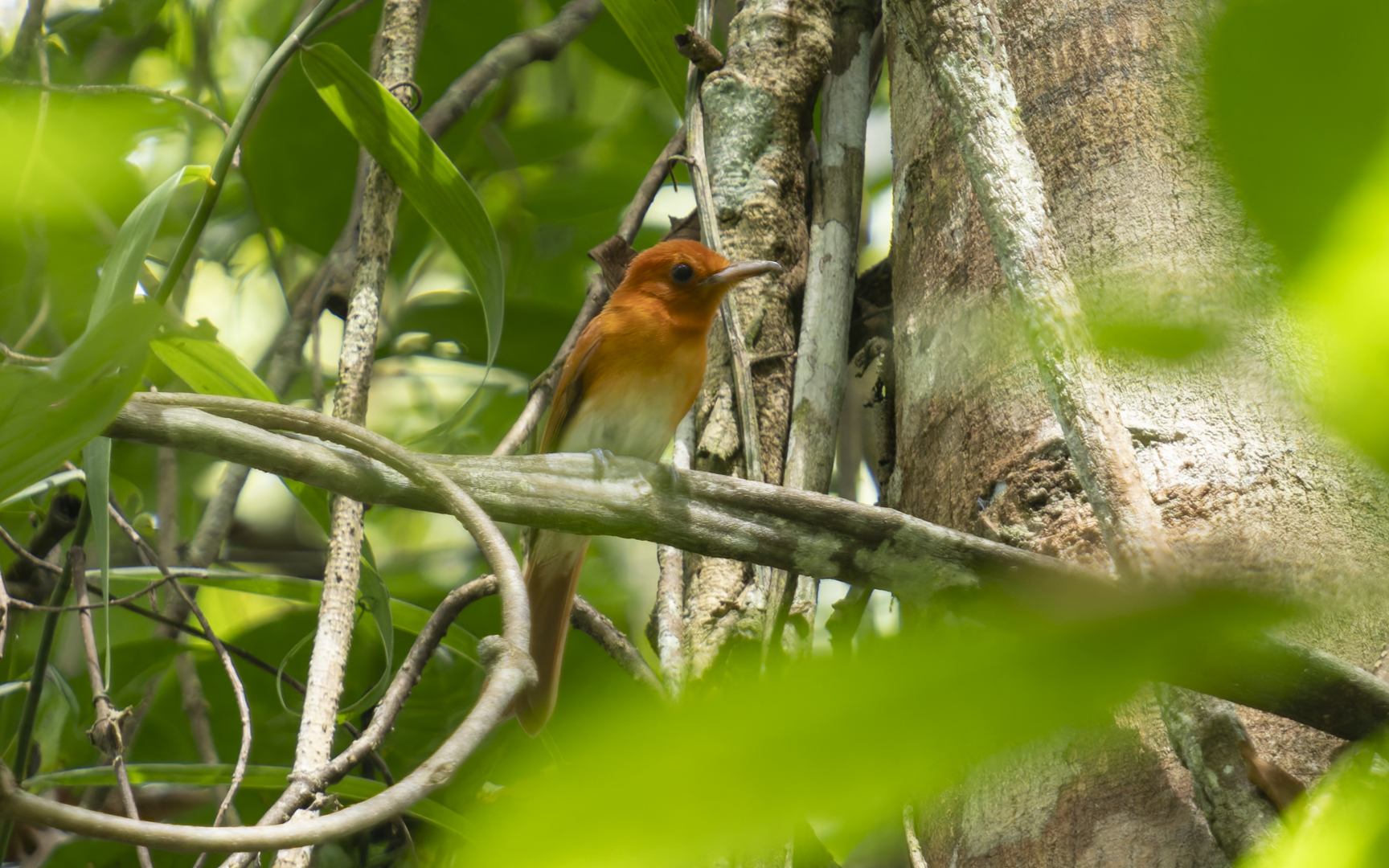
Terpsiphone cinnamomea – アカサンコウチョウ
Scientific Name: Terpsiphone cinnamomeaEnglish Name: Rufous Paradise-FlycatcherObserved in: PICOPLocal Status: N/AObserved Timing: Jun-24 サンコウチョウであり、しかも赤いのです。存在を知った時から是非とも出会いたいと期待していた種です。PICOPでは数個体を確認することはできましたが、如何せん樹上の遠くにいるのでなかなか手ごわい相手でした。 フィリピンの準固有種で、国外ではインドネシアのごく一部に生息するのみです。
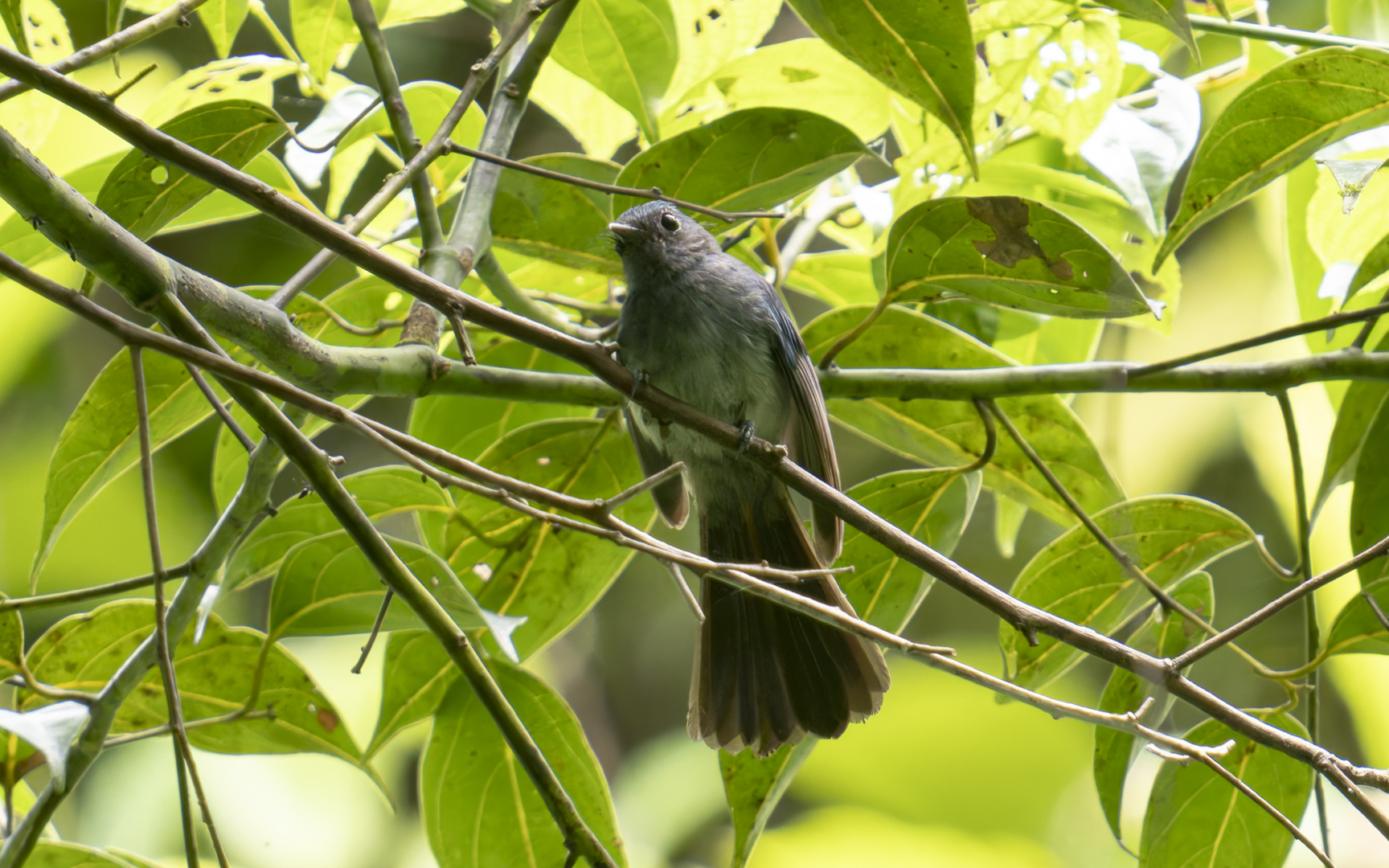
Rhipidura superciliaris – アオオウギビタキ
Scientific Name: Rhipidura superciliarisEnglish Name: Mindanao Blue-FantailObserved in: PICOPLocal Status: Endemic in MindanaoObserved Timing: Jun-24 青味がかった体色が特徴のオウギビタキで、ミンダナオの固有種です。写真は光がうまく当たっておらず、色がよくでていないですね。撮り直しの機会を伺います。
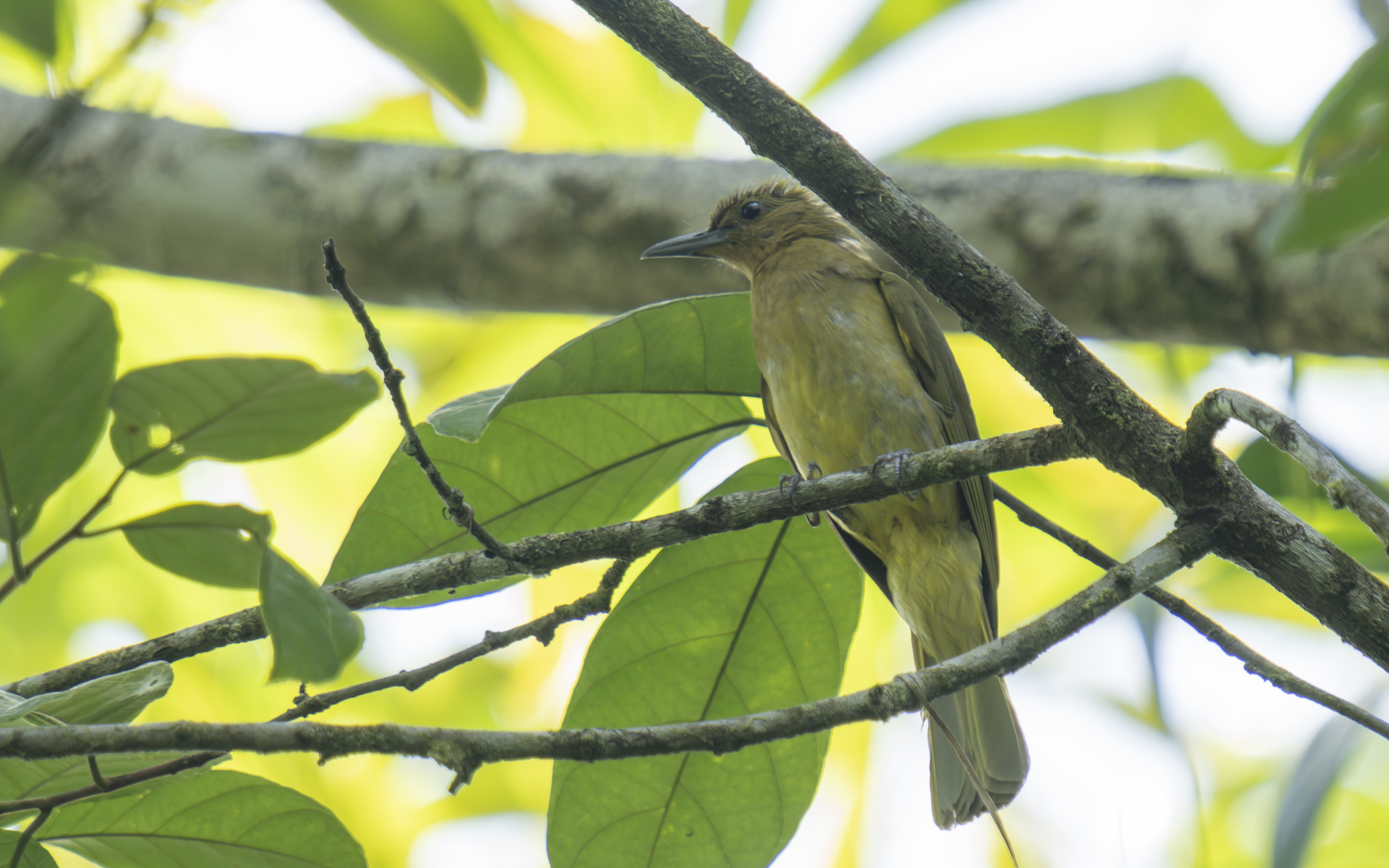
Hypsipetes everetti – キバラヒヨドリ
Scientific Name: Hypsipetes everettiEnglish Name: Yellowish BulbulObserved in: PICOPLocal Status: EndemicObserved Timing: Jun-24 Yellowishとはなんとも雑な名前を付けられたなと思います。腹部が全面黄色がかっていることでチャムネヒヨドリと区別ができます。Suluには同種ですが色のパターンが異なるものが分布しているようです。
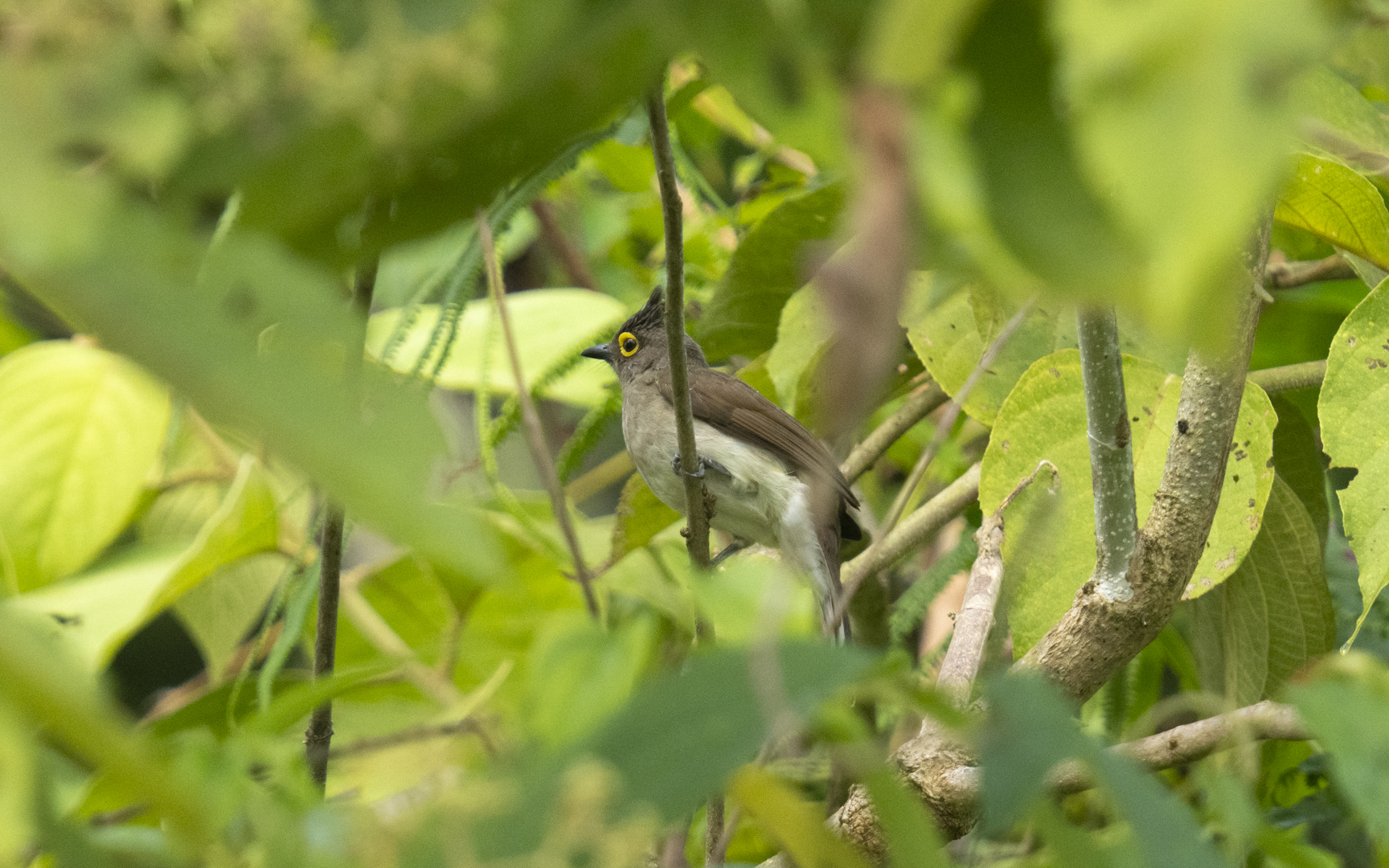
Microtarsus urostictus – メガネヒヨドリ
Scientific Name: Microtarsus urostictusEnglish Name: Yellow-wattled BulbulObserved in: PICOPLocal Status: EndemicObserved Timing: Jun-24 トサカとメガネが特徴的です。早朝、草木の茂みの中から餌を啄みに姿を見せてくれました。フィリピン全土(パラワン島を除く)に分布します。
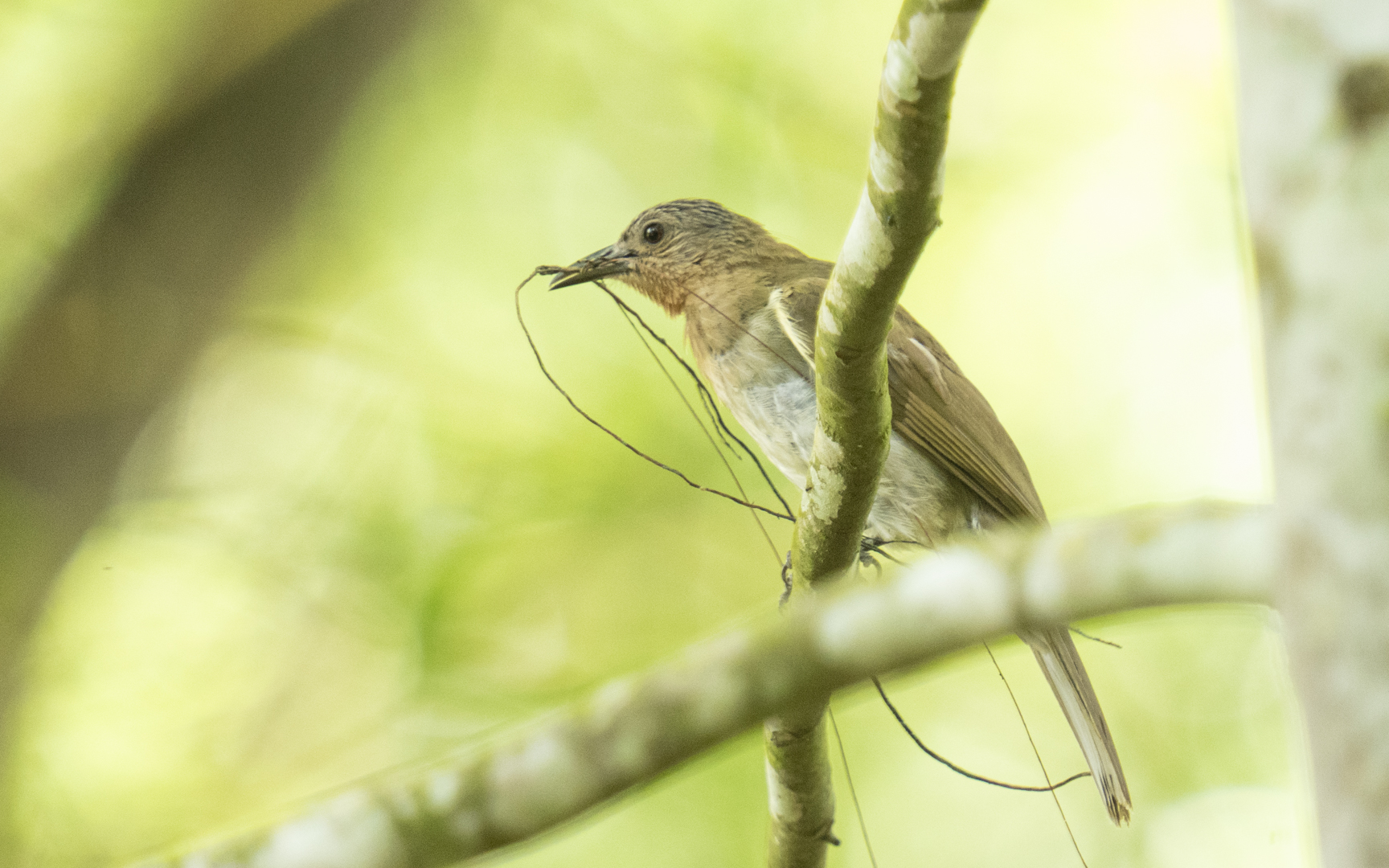
Hypsipetes philippinus – チャムネヒヨドリ
Scientific Name: Hypsipetes philippinusEnglish Name: Philippine BulbulObserved in: DavaoLocal Status: EndemicObserved Timing: Jun-24
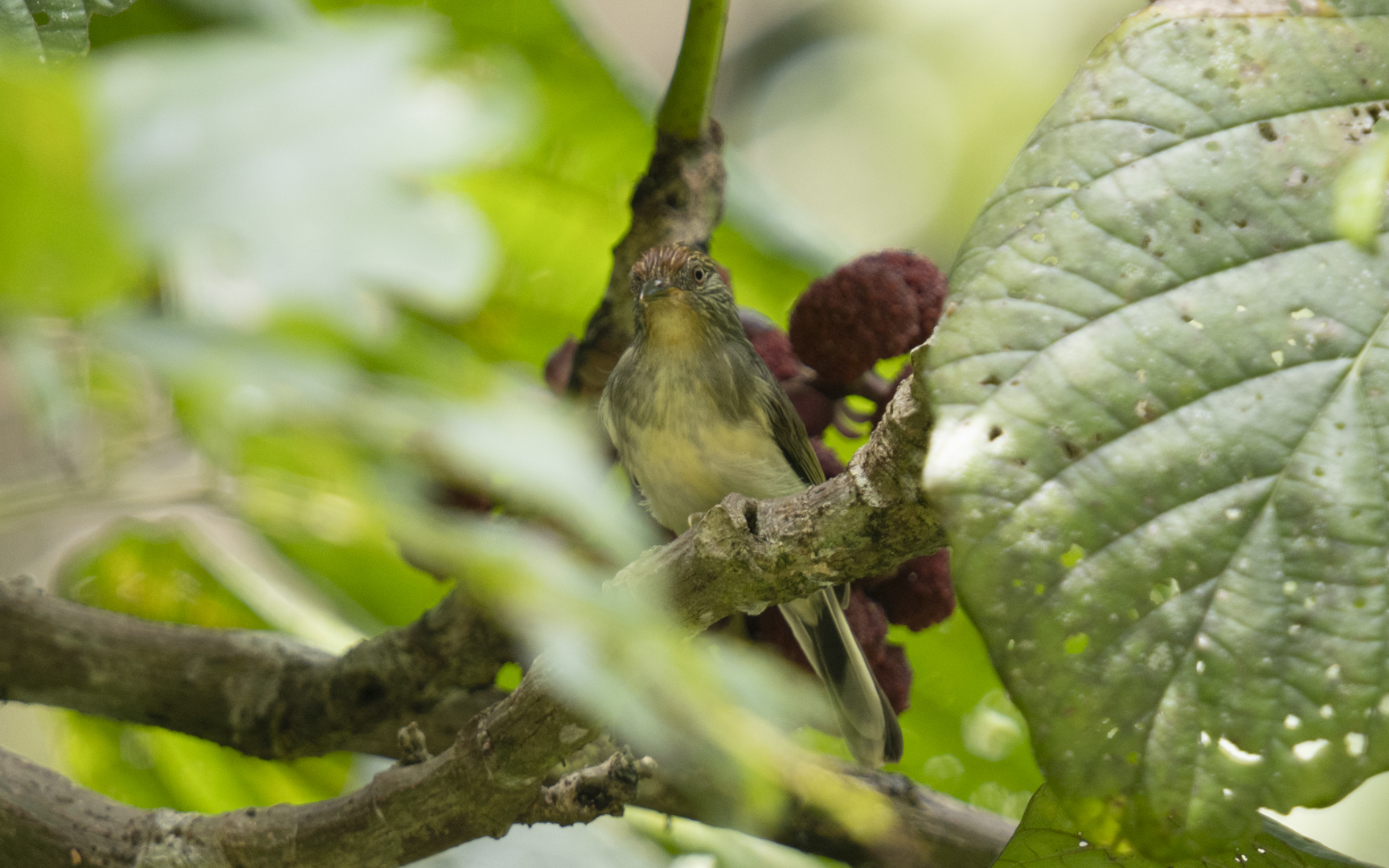
Dasycrotapha plateni – コビトモリチメドリ
Scientific Name: Halcyon smyrnensisEnglish Name: Mindanao Pygmy-BabblerObserved in: PICOPLocal Status: Endemic in Mindanao (NT)Observed Timing: Jun-24 込み入った草木の暗がりを移動して回るので、撮影には大変苦労しました。準絶滅危惧種の貴重なミンダナオ固有種です。
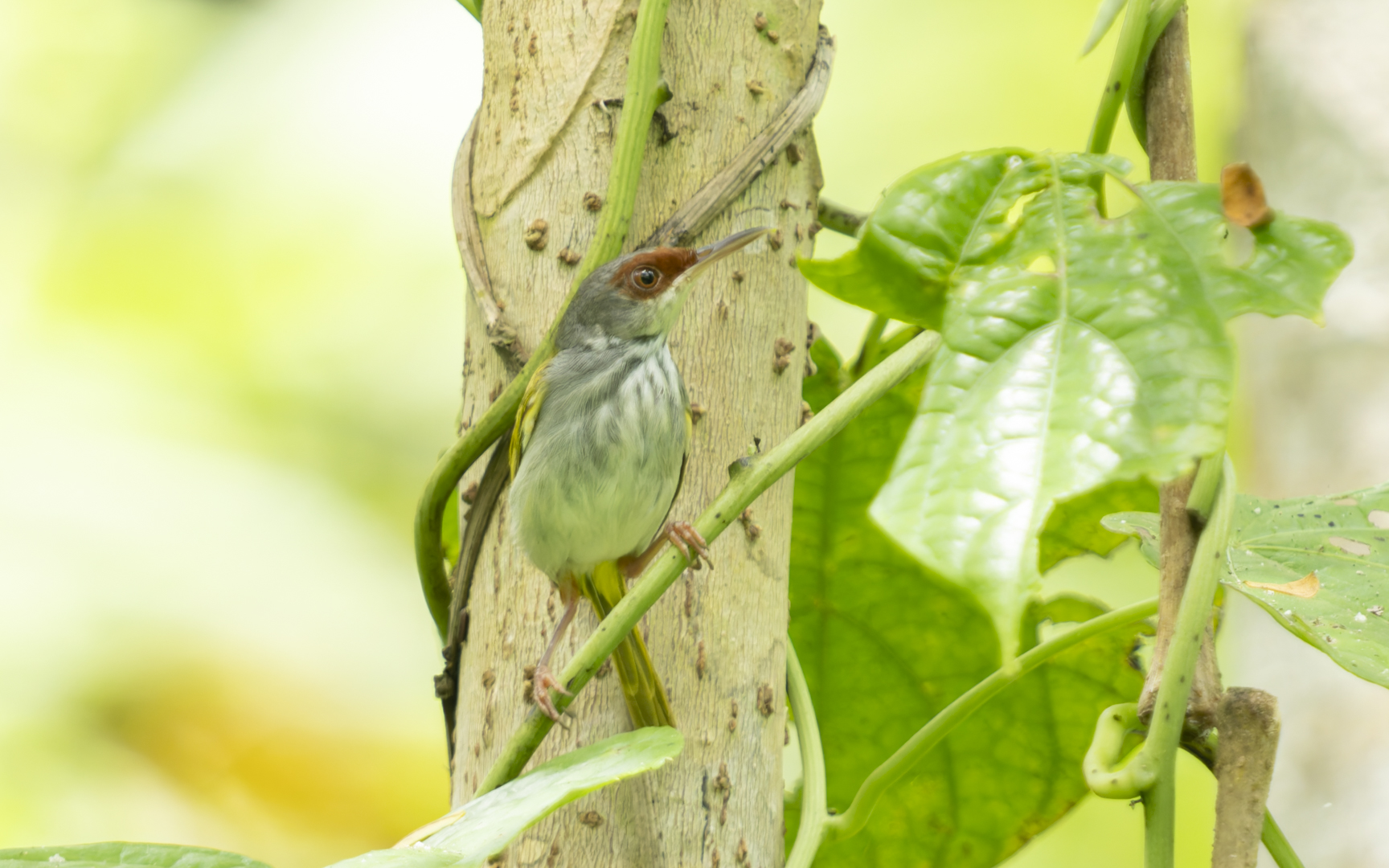
Orthotomus frontalis
Scientific Name: Orthotomus frontalisEnglish Name: Rufous-fronted TailorbirdObserved in: PICOPLocal Status: EndemicObserved Timing: Jun-24
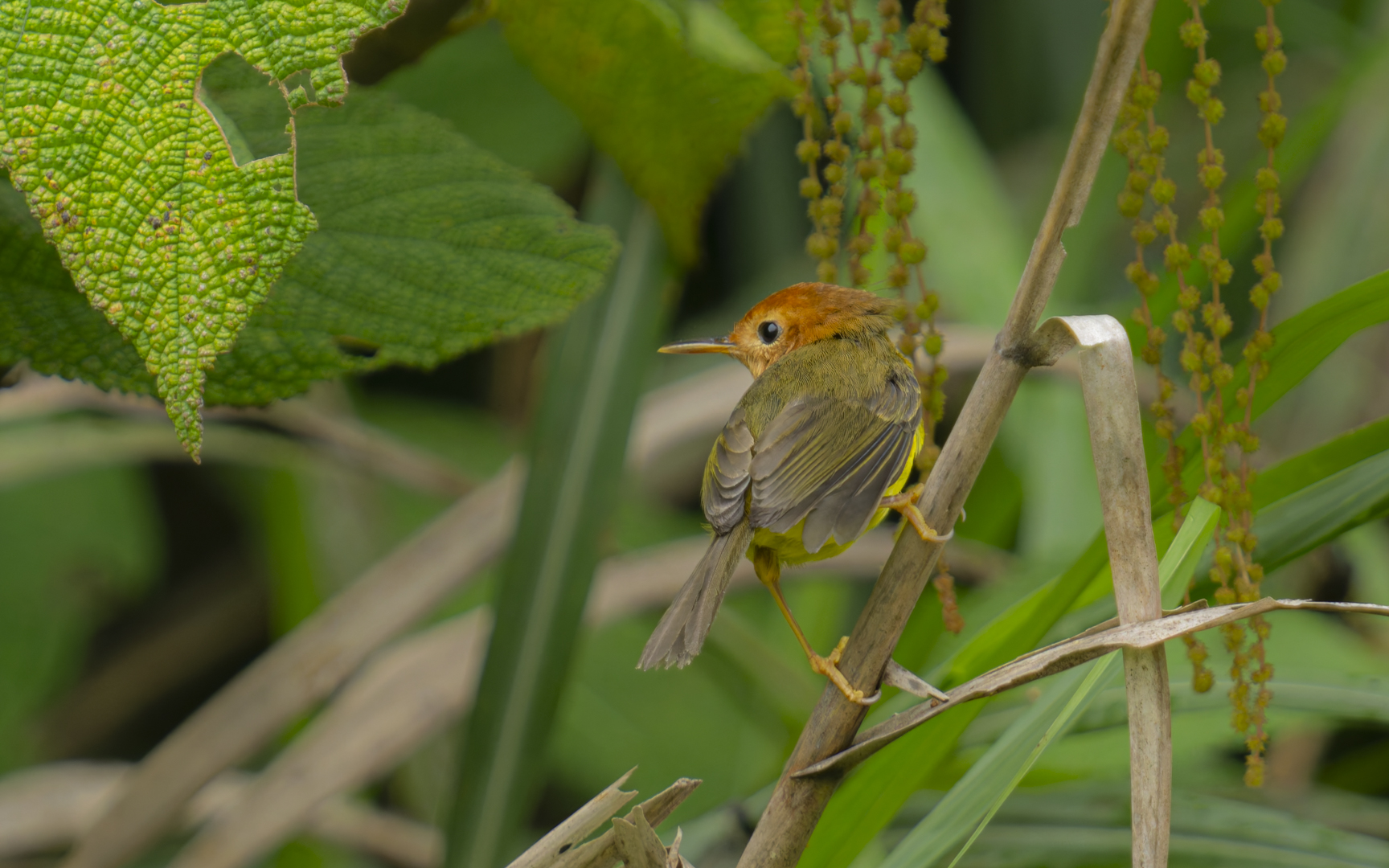
Phyllergates heterolaemus – ミンダナオサイホウチョウ
Scientific Name: Phyllergates heterolaemusEnglish Name: Rufous-headed TailorbirdObserved in: ComValLocal Status: Endemic in MindanaoObserved Timing: Jun-24 高地に生息するミンダナオ固有種のサイホウチョウ。オレンジ色の頭部が目を引く、美しい鳥です。
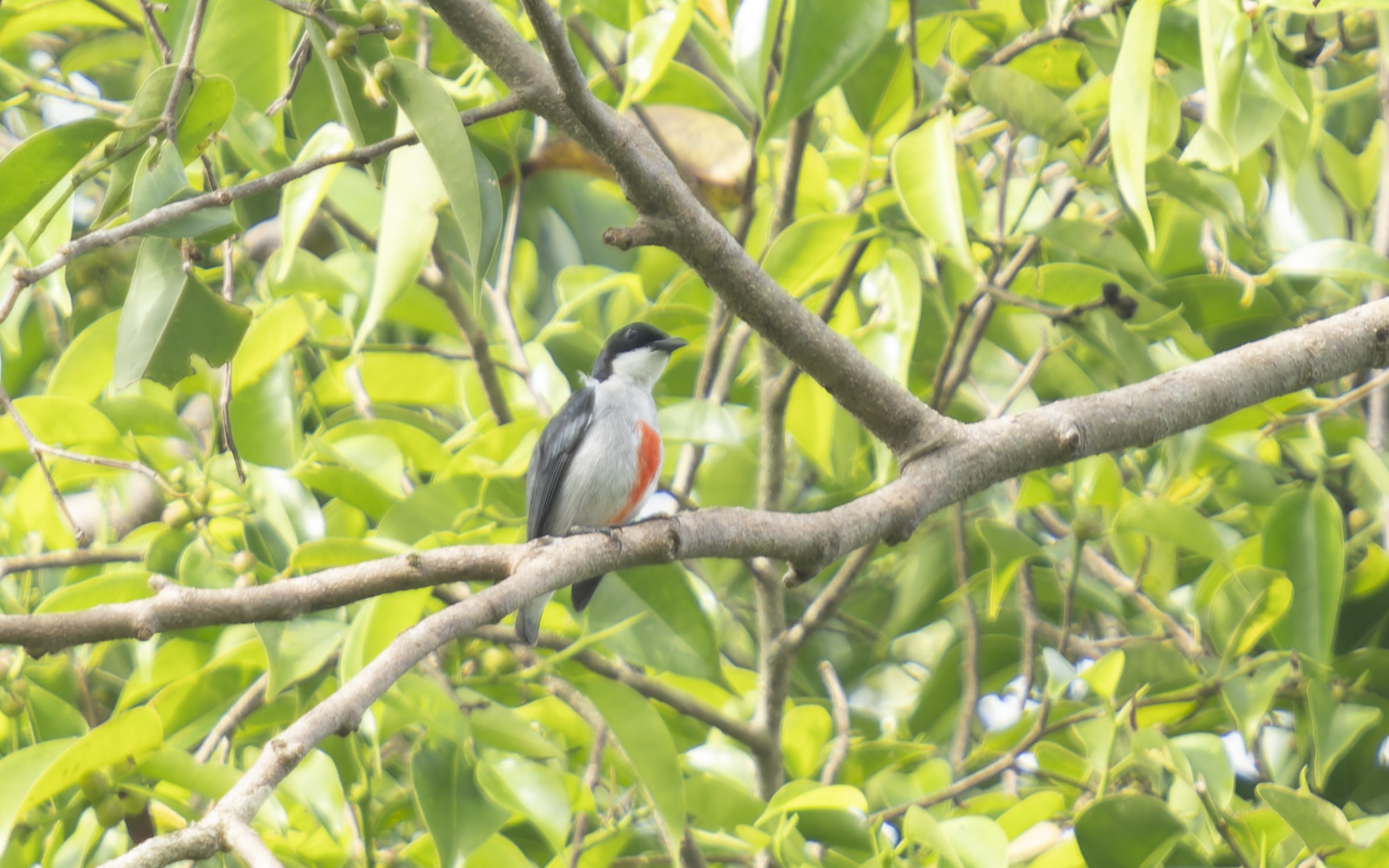
Dicaeum australe – ゴシキハナドリ
Scientific Name: Dicaeum australeEnglish Name: Red-keeled FlowerpeckerObserved in: PICOPLocal Status: EndemicObserved Timing: Jun-24
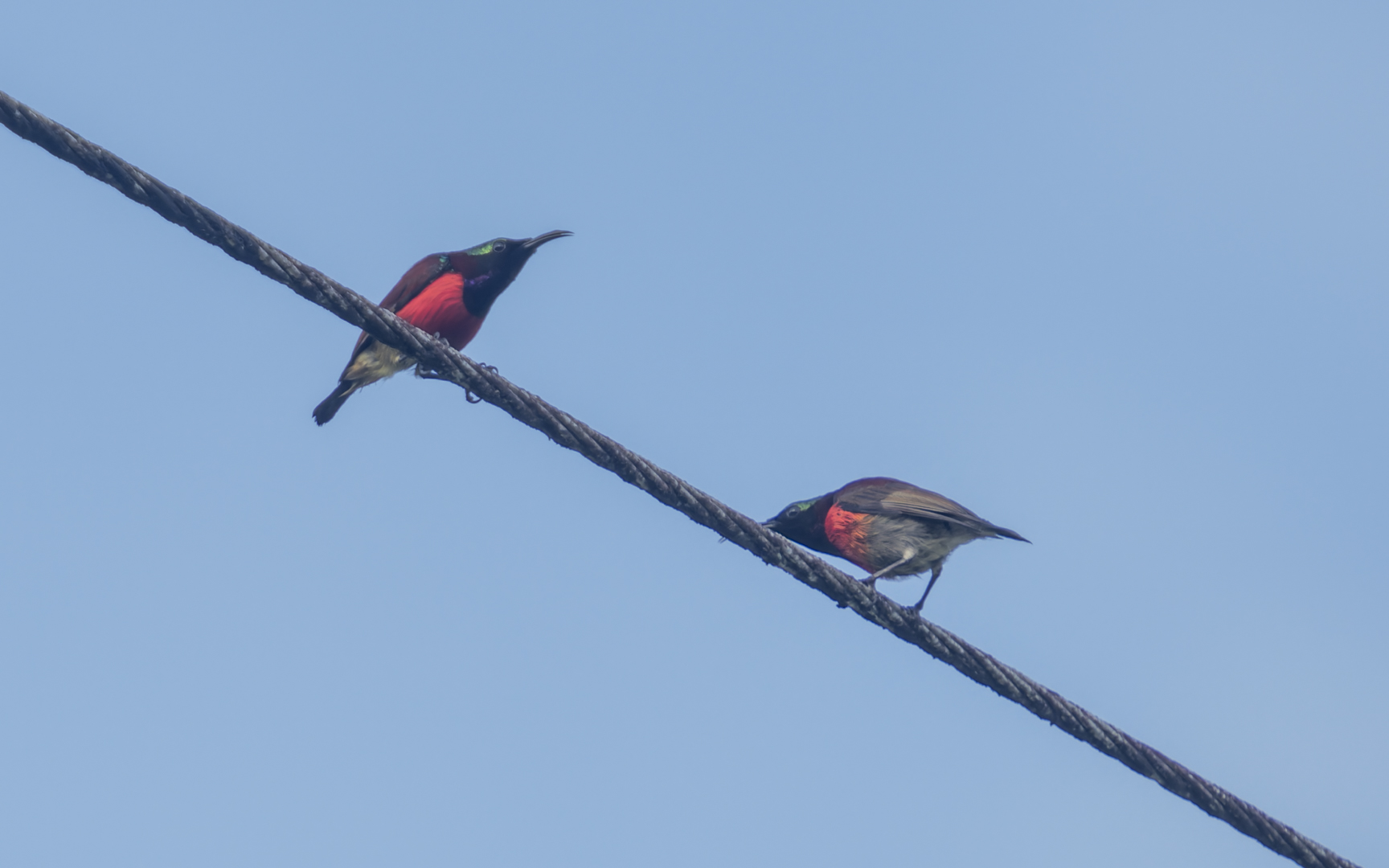
Leptocoma sperata – ムネアカタイヨウチョウ
Scientific Name: Leptocoma sperataEnglish Name: Purple-throated SunbirdObserved in: PICOPLocal Status: N/AObserved Timing: Jun-24 ど派手な見た目をしたタイヨウチョウです。固有種と思いきや固有種ではないのは、マレーシアのサバ州やインドネシアのカリマンタンでも見ることができるからですが、限定された地域のため、準固有種と言って差し支えないと思います。
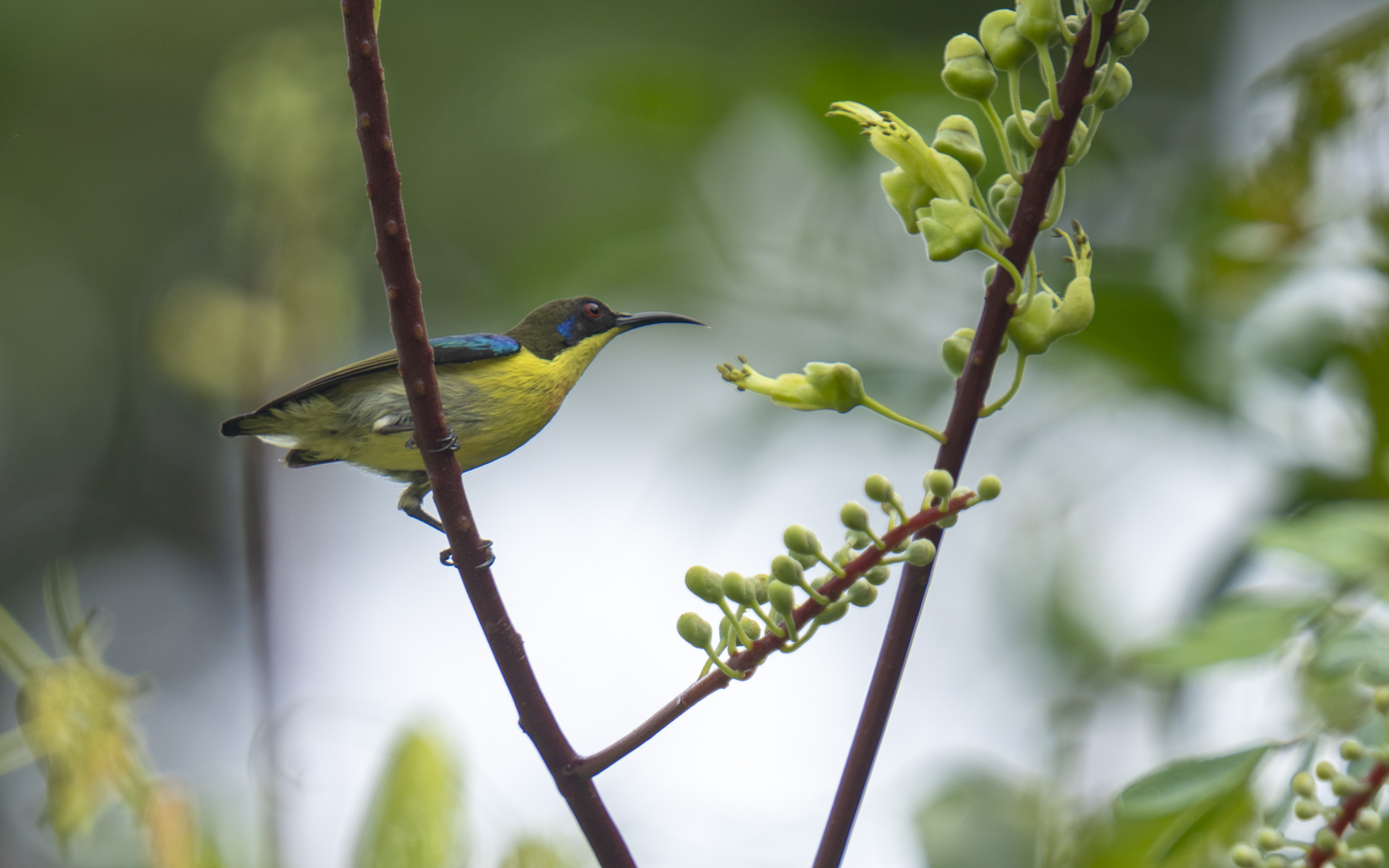
Aethopyga pulcherrima – キムネタイヨウチョウ
Scientific Name: Aethopyga pulcherrimaEnglish Name: Metallic-winged SunbirdObserved in: PICOPLocal Status: EndemicObserved Timing: Jun-24 低地に生息する固有種のタイヨウチョウ。ギラギラに照り付ける太陽の下で、気力を振り絞って撮影しました(いや、振り絞れていないか。。)。
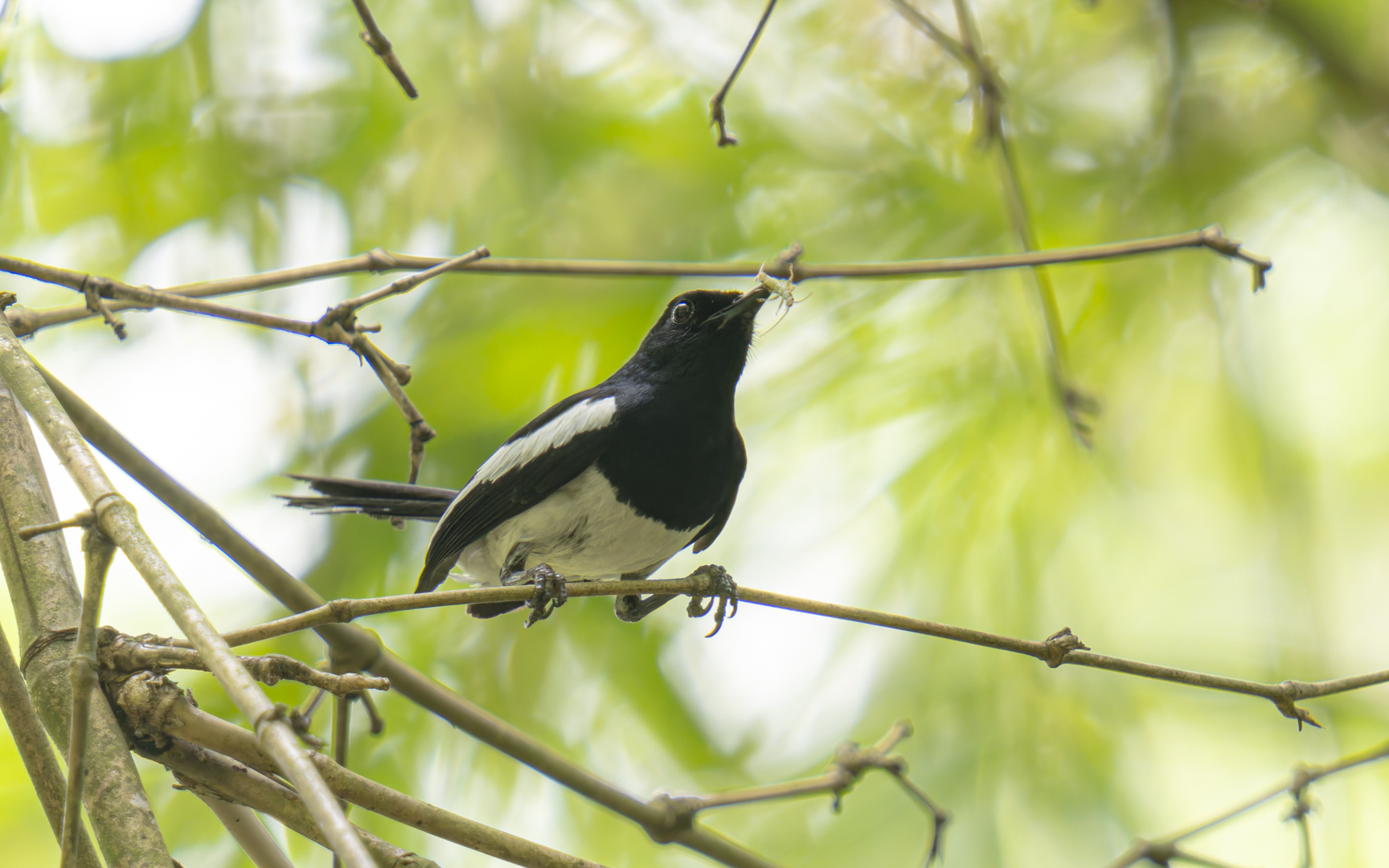
Copsychus mindanensis – フィリピンシキチョウ
Scientific Name: Copsychus mindanensisEnglish Name: Philippine Magpie-RobinObserved in: PICOPLocal Status: EndemicObserved Timing: Jun-24 Palawan以外のフィリピンに広く分布する固有種です。シキチョウと異なり、上部は濃い藍色をしています。
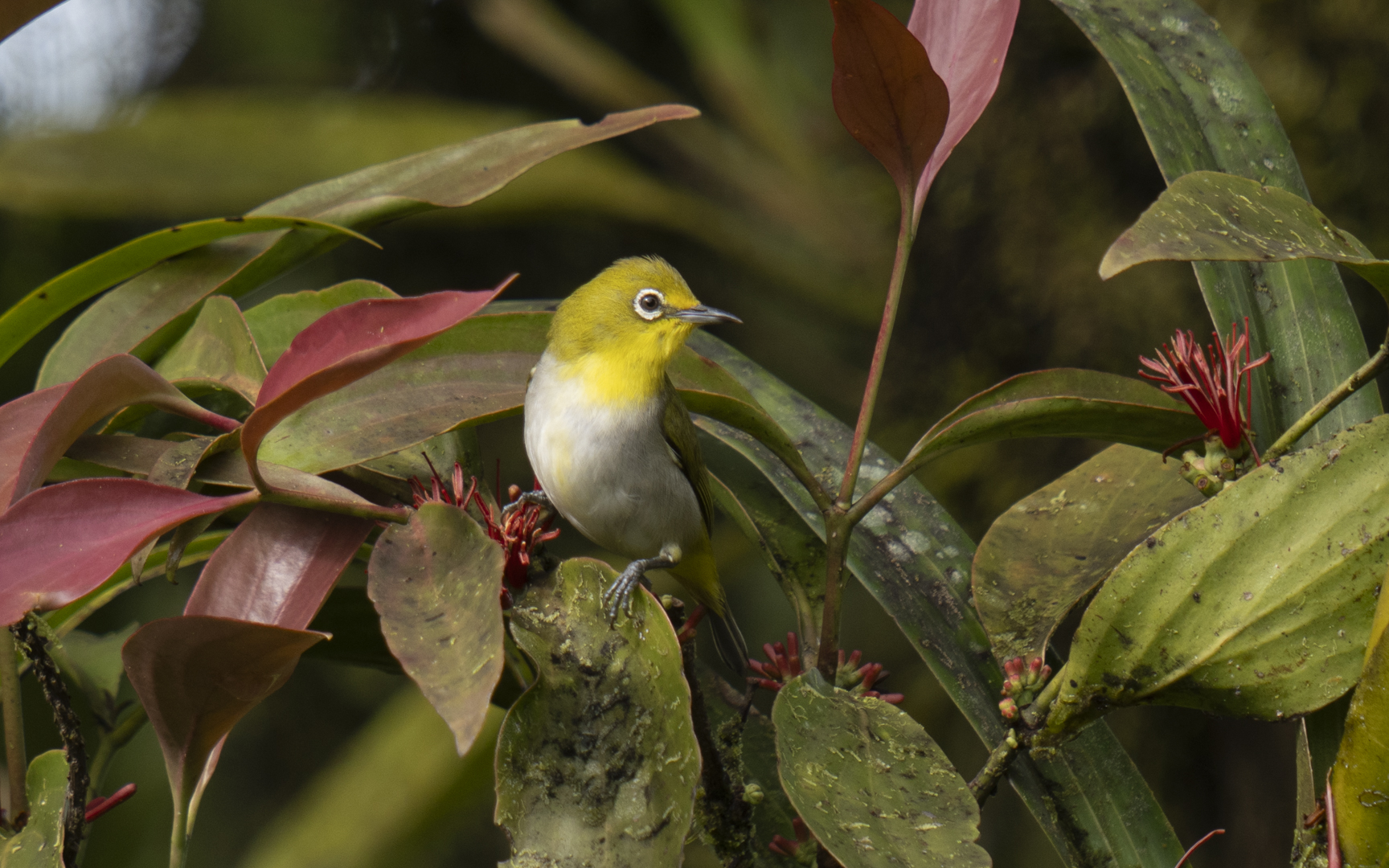
Zosterops japonicus – メジロ
Scientific Name: Zosterops japonicusEnglish Name: Warbling White-eyeObserved in: ComValLocal Status: Common ResidentObserved Timing: Jun-24 メジロ科の同定は似た種が多すぎて難しいですが、当種はおそらくメジロでしょう。学名の通り日本で見られるあのお馴染みのメジロです。東南アジア各地はもちろん、海を越えてハワイにまで生息しているようです。フィリピンでも一般種で、比較的標高の高い地域で観察されます。
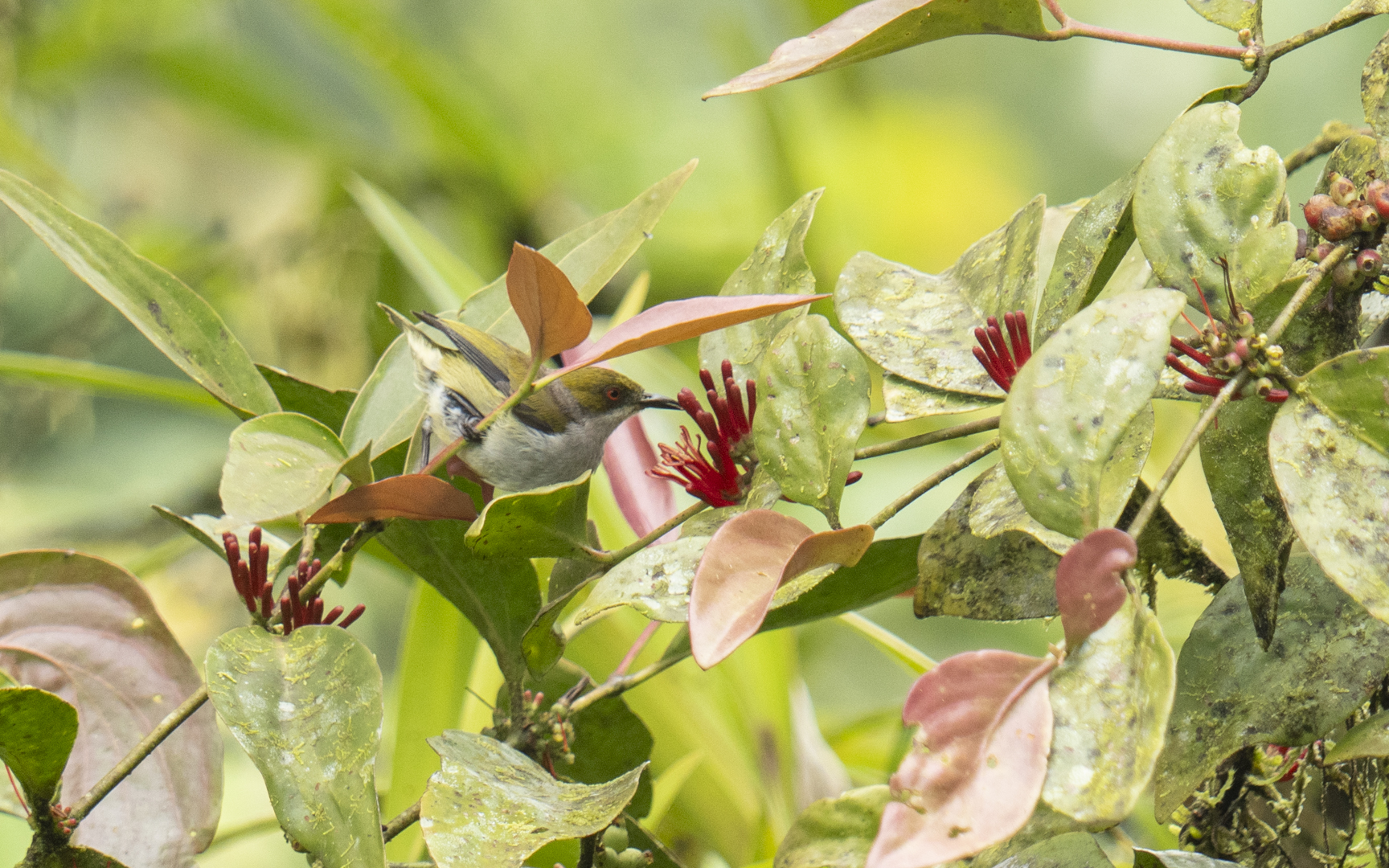
Dicaeum nigrilore – ハシナガハナドリ
Scientific Name: Dicaeum nigriloreEnglish Name: Olive-capped FlowerpeckerObserved in: PICOPLocal Status: Endemic in MindanaoObserved Timing: Jun-24 ミンダナオの固有種で、高地に生息します。オリーブハナドリモドキ(Prionochilus olivaceus, Olieve-backed Flowerpecker, フィリピン固有種)と似ますが、当種は腹部に模様が入らないなど見分けは容易です。また、名前の通り、すらっと伸びたクチバシも当種の特徴です。
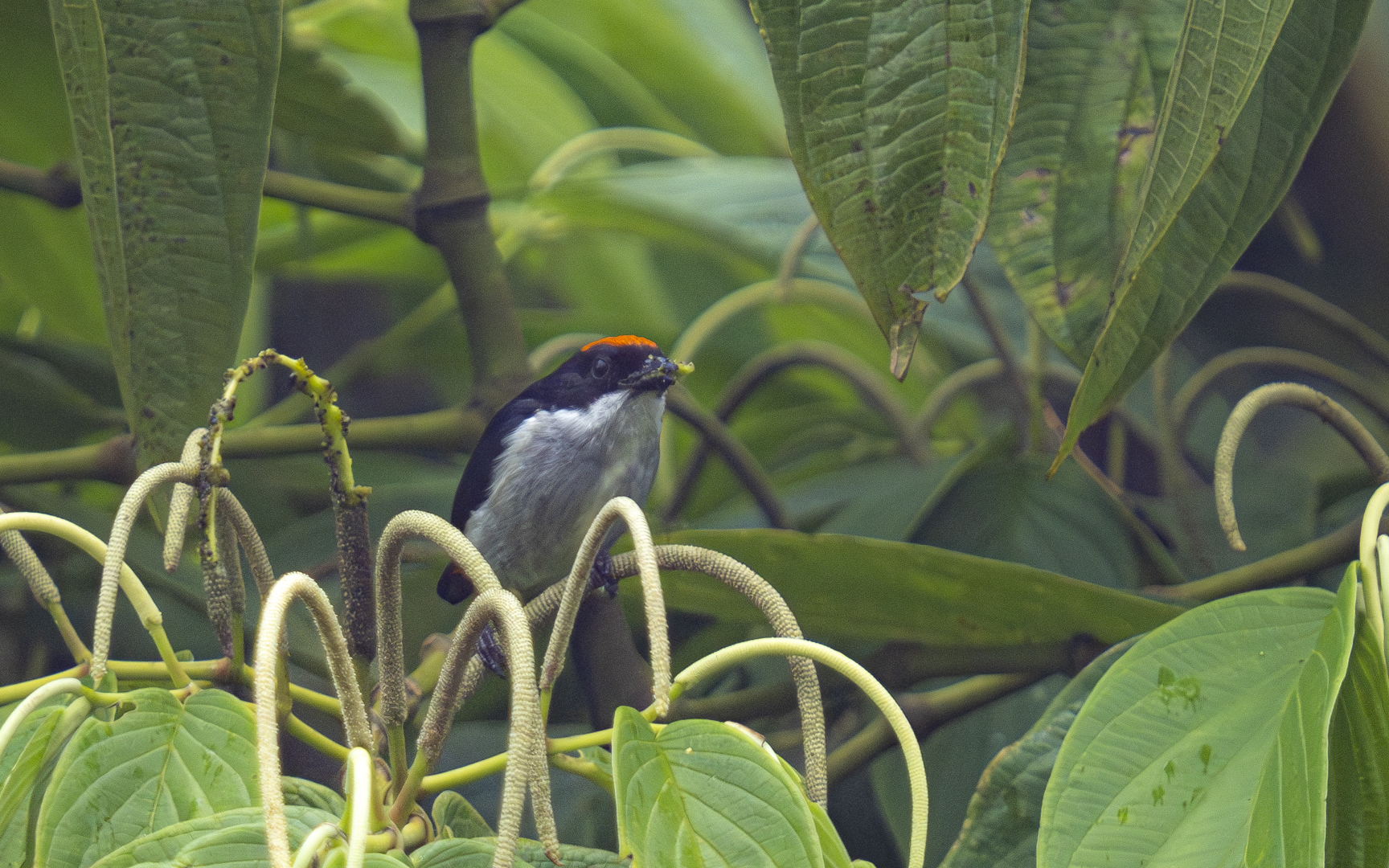
Dicaeum kampalili
Scientific Name: Dicaeum kampaliliEnglish Name: Flame-crowned FlowerpeckerObserved in: ComValLocal Status: Endemic of MindanaoObserved Timing: Jun-24 ミンダナオの固有種で、赤い頭部が特徴のハナドリです。和名はありませんが、付けるならばアカボウシハナドリでしょうか。 以前は、ルソン島に生息するキボウシハナドリ、Yellow-crowned Flowerpecker (Dicaeum anthonyi) と同種とみなされていました。
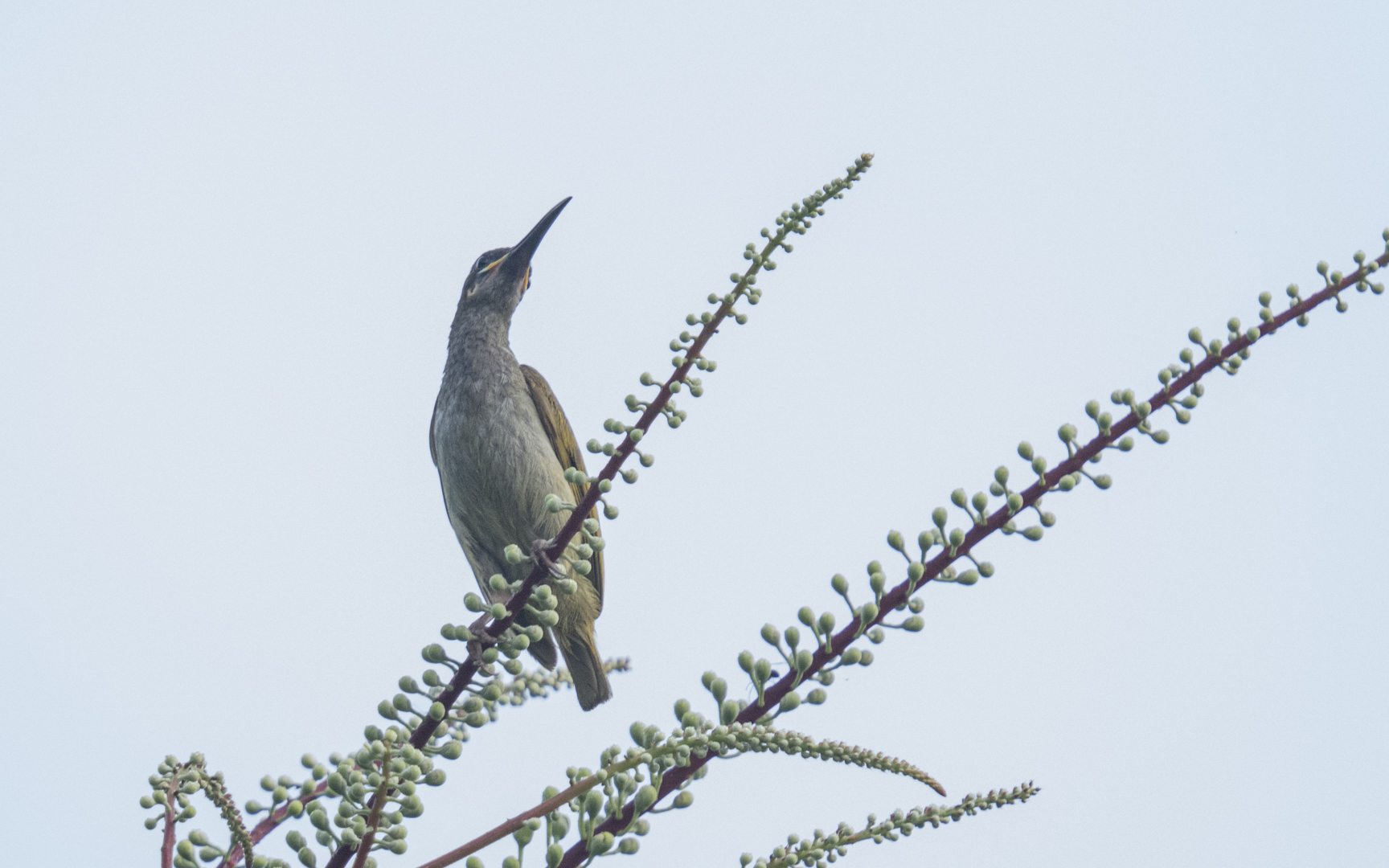
Arachnothera clarae – ホオハゲクモカリドリ
Scientific Name: Arachnothera claraeEnglish Name: Naked-faced spiderhunterObserved in: PICOPLocal Status: EndemicObserved Timing: Jun-24 名前の通り頬っぺたの部分が一部ハゲています。その特徴を写真に収める間もなく飛び立ってしまったのは残念でした。
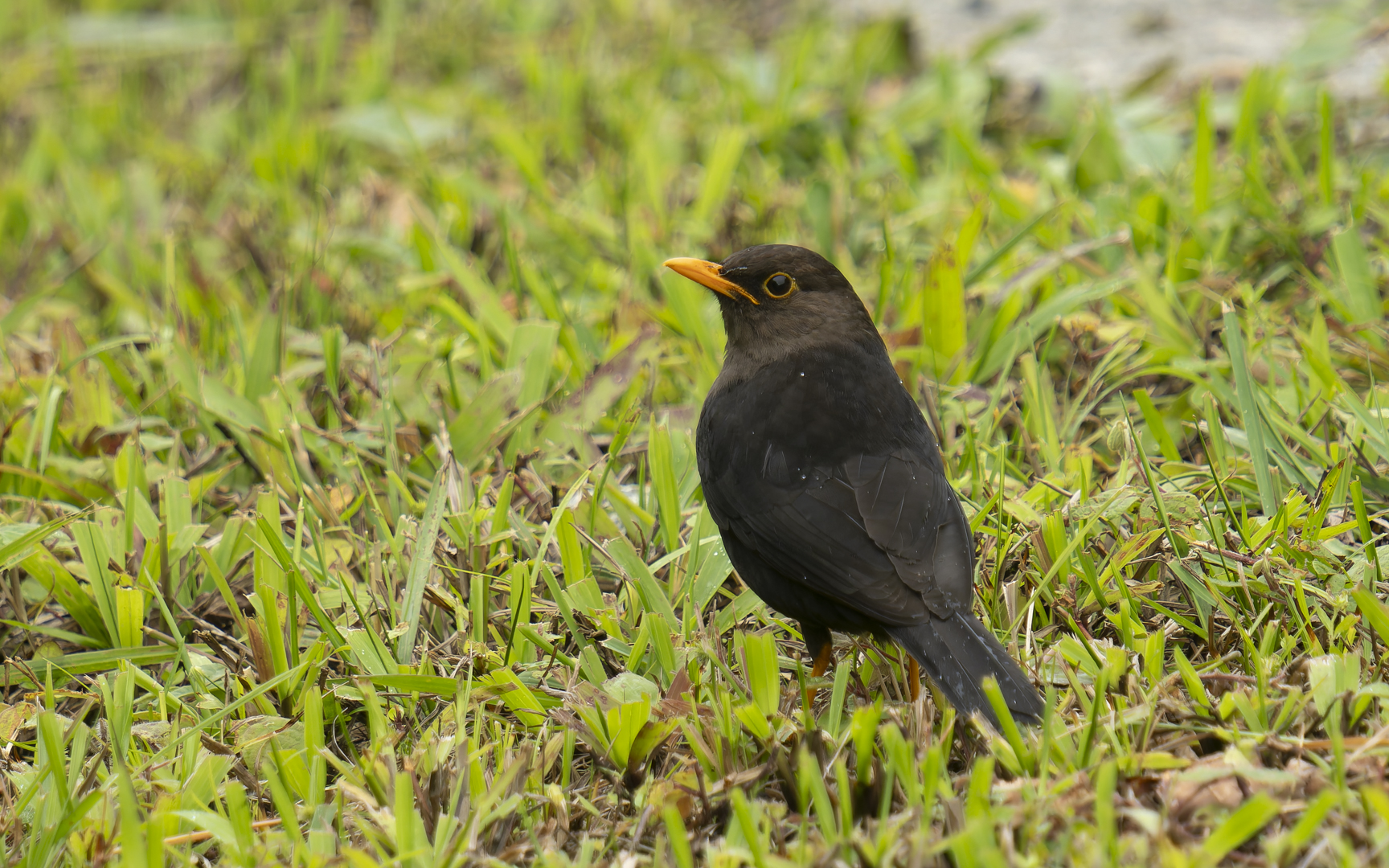
Turdus nigrorum – ミンダナオツグミ
Scientific Name: Turdus nigrorumEnglish Name: Mindanao Island-ThrushObserved in: ComValLocal Status: EndemicObserved Timing: Jun-24 1,000m以上の高地に生息する固有種のツグミです。雨上がりの道路わきの草むらで餌を啄むのに夢中だったのか、距離を詰めても全く動じない個体でした。国内では南北様々な地域で見られるようです。
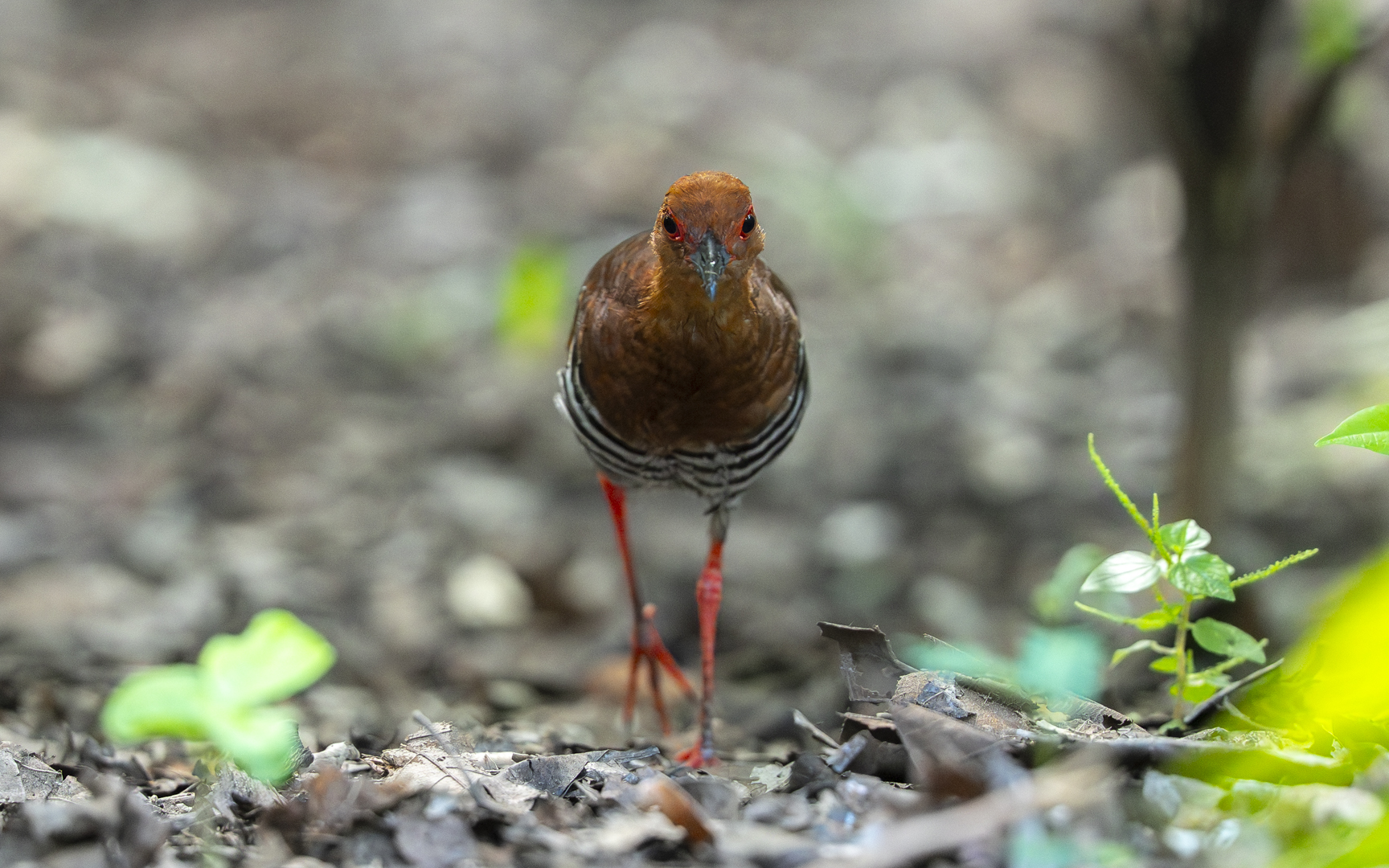
Rallina fasciata – ナンヨウオオクイナ
Scientific Name: Rallina fasciataEnglish Name: Red-legged crakeObserved in: Singapore Botanic GardenLocal Status: Common residentObserved Timing: Mar-25 シンガポールで見ておきたい鳥、ナンヨウオオクイナです。すらりと伸びた美脚と縞々のパンツ、赤い縁取りの釣り目、、美人な要素をいくつも持ったスターバードです。 これまで幾度となく訪れてきたSingapore Botanic Gardenに生息していることは様々な情報から知ってはいたのですが、真面目に当種をターゲティングしてこなかったため、3年以上に亘って撮り逃してきました。同期間には当種よりもずっと珍しい、Slaty-legged CrakeがPasir Ris Parkに出ていましたが人だかりを想像して敬遠していまいました。
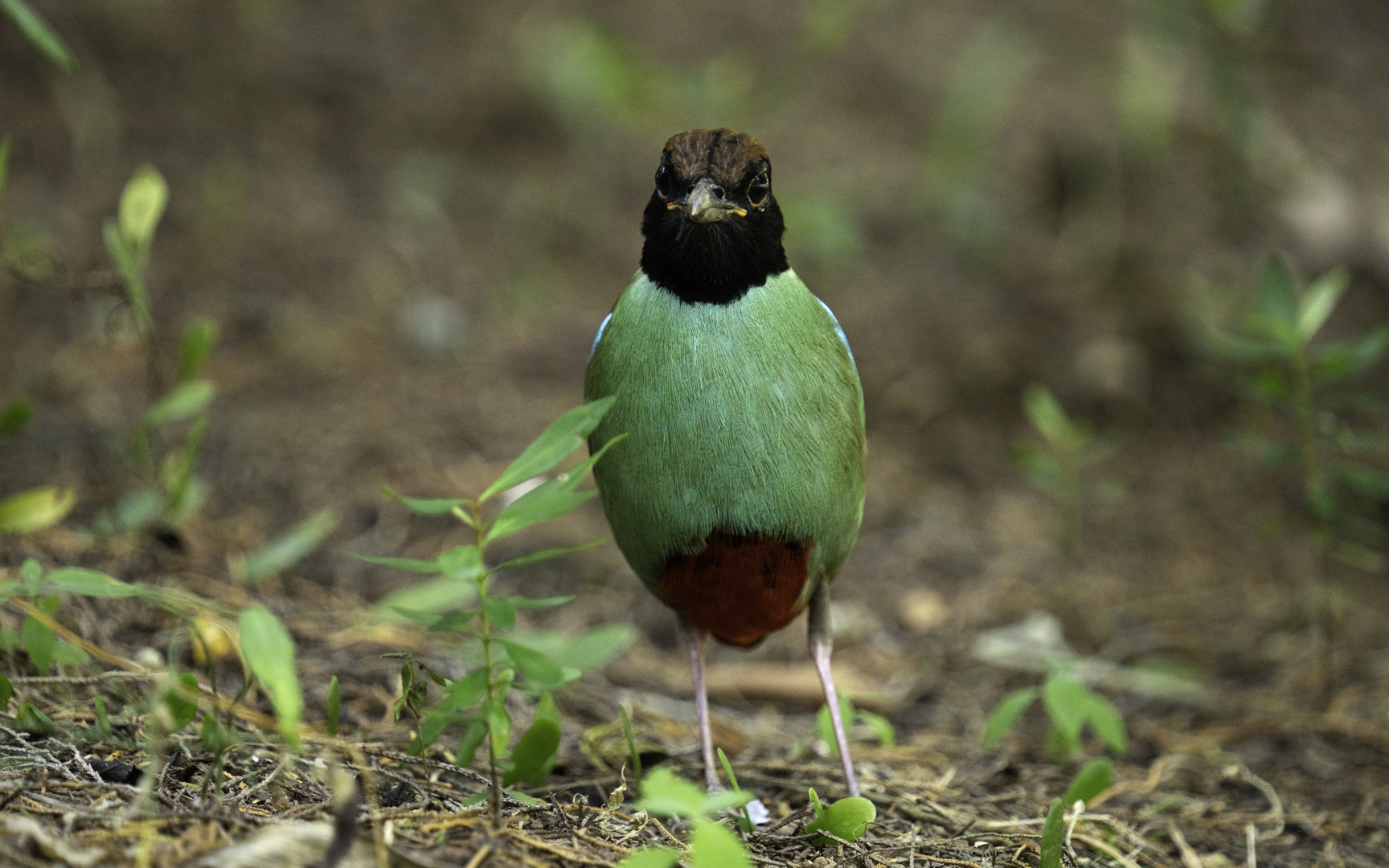
Pitta sordida – ズグロヤイロチョウ
Scientific Name: Pitta sordidaEnglish Name: Hooded PittaObserved in: Tampines, Jurong WestLocal Status: Uncommon migrantObserved Timing: Dec-21, Jan-23 当地に赴任して間もない2021年の11月。Hindhede Nature Parkを訪れたその日、早朝から長蛇の列が公園口にできあがっていた。パンデミックで入場制限でもかかっているのかと並んでみると、実はFairy Pittaを目的にBirderが大挙して押し寄せていたのであった。Pittaという鳥を認識したのはその時であった。その後もJurong Lake GardenにBlue-winged Pittaが長らく目撃されているなどしていたが、どういうわけか機会を逃し続け、私にとって漸く初見のお目見えとなった当科が当種となったのである。想像していたよりも一回り大きいが、ペンギンを彷彿とさせるフォルムや動きが卑怯なまでに愛らしい。東南アジアに数種が分布しており、そのどれもが選ばれしスターバード然とした美しい鳥だ。
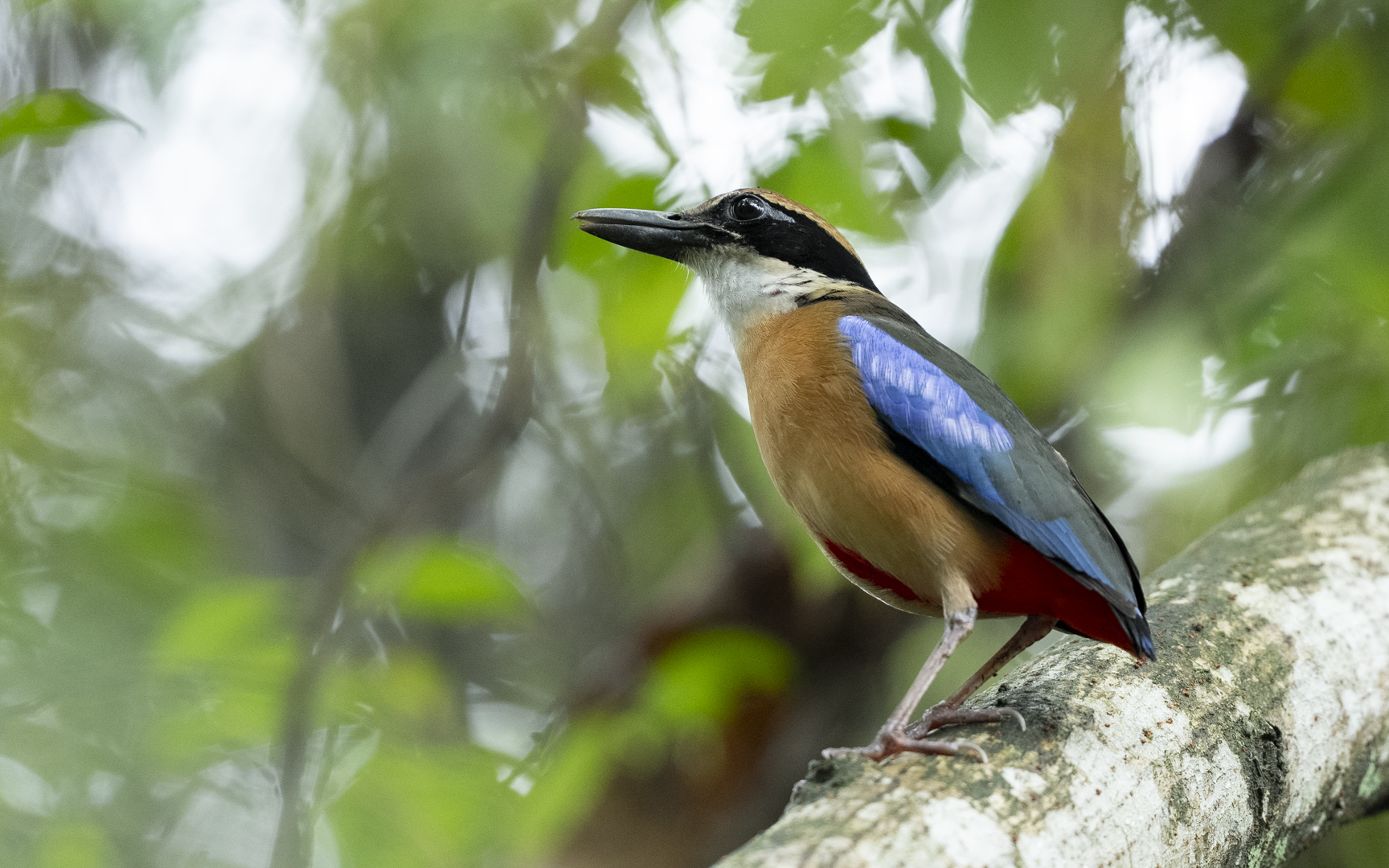
Pitta megarhyncha – マングローブヤイロチョウ
Scientific Name: Pitta megarhynchaEnglish Name: Mangrove PittaObserved in: Pulau UbinLocal Status: Uncommon residentObserved Timing: May-25 シンガポールに住んでいるうちに観察をしておきたい鳥の1つが当種でした。マングローブを散策するたびに当種がいないものかと淡い期待をしてみましたが、2025年まで音沙汰もありません。どうしたものかと入念な下調べをしてみると、当種の観察が期待できるのはシンガポール国内では、もはやPulau Ubinのみであり、その中の特定の場所で見られていることがわかりました。 そうして場所に向かってみると、激しく鳴き交わしている声が聞こえ、やがて姿を現してくれたのです。よく似たミナミヤイロチョウに比べて、顕著に大きなクチバシが特徴です。
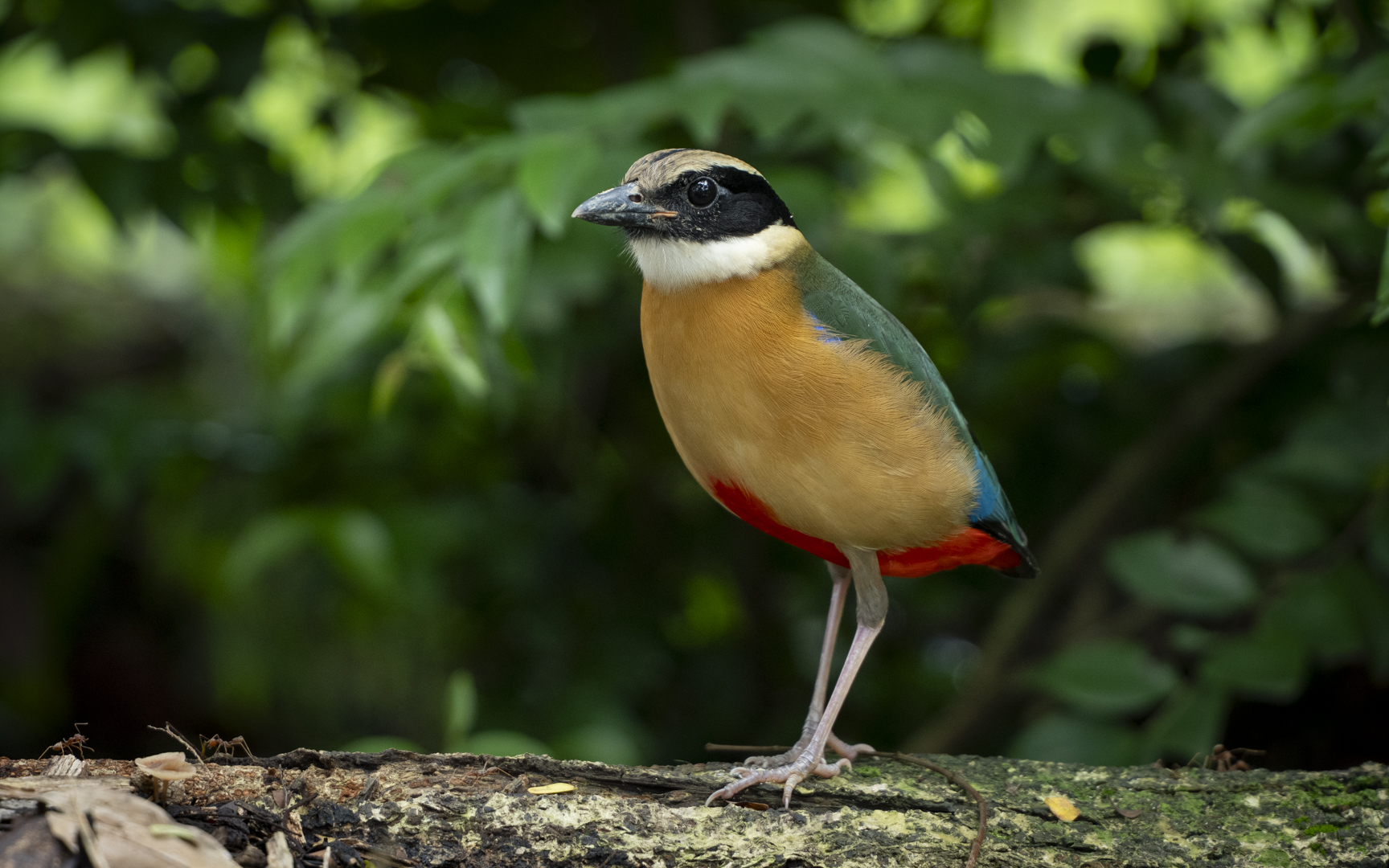
Pitta moluccensis – ミナミヤイロチョウ
Scientific Name: Pitta moluccensisEnglish Name: Blue-winged PittaObserved in: Bedok Reservoir, Punggol ParkLocal Status: Uncommon MigrantObserved Timing: Jan-23, Nov-24 何を好んでHDBに現れるのだろう。自身の人気ぶりを理解して餌付けされにでも来てるんじゃないだろうかと勘繰ってしまいたくなる。自然を相手に撮影する醍醐味は一期一会のその瞬間であり、偶然性は重要な要素である。そして、自然への関心や技術の修練を通して切り取れる瞬間は多様なものになっていく、つまり確率ゲームだけではなくなっていく、その過程こそが楽しい。というのをわざわざ書いたのは、当個体が餌付けされていたからである。この美しい鳥に出会えたこと自体は素晴らしい体験であったことは間違いないのだけど、なんとも複雑な気持ちにもなる。 (追記)その後、毎年のように目撃例があるミナミヤイロチョウですが、2024年は公園の一角、フェンスで囲まれたドッグランエリアの植え込みに現れました。ズングリしているイメージですが、背を伸ばすと意外にスレンダーですね。
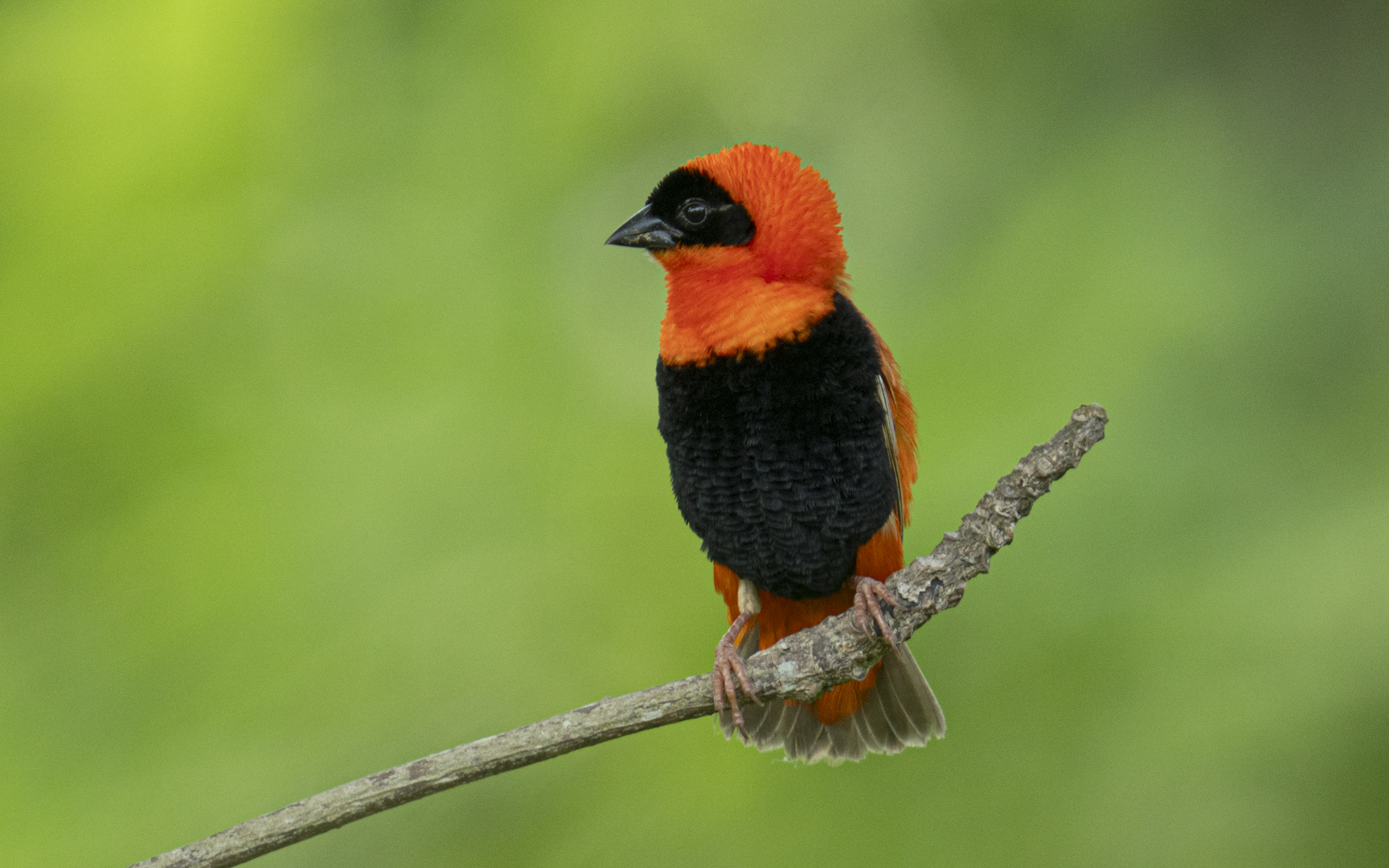
Euplectes orix – オオキンランチョウ
Scientific Name: Euplectes orixEnglish Name: Southern Red BishopObserved in: Changi Bay PointLocal Status: Uncommon introduced residentObserved Timing: May-24 ムナグロキンランチョウと同じくChangi Bay Pointに生息しており、緑を背景にオレンジが映える、なんともアイコニックな出で立ちをしています。 元来の生息域はアフリカ南部であり、ケニアから南アフリカまで広く分布しています。よく似た種にキタキンランチョウがおりサハラ以南の南北ですみわけをしているようです。 シンガポールにおける外来種の鳥たちについてはフランシスさんがおまとめになられてる記事が非常に有用です。ありがたや。。
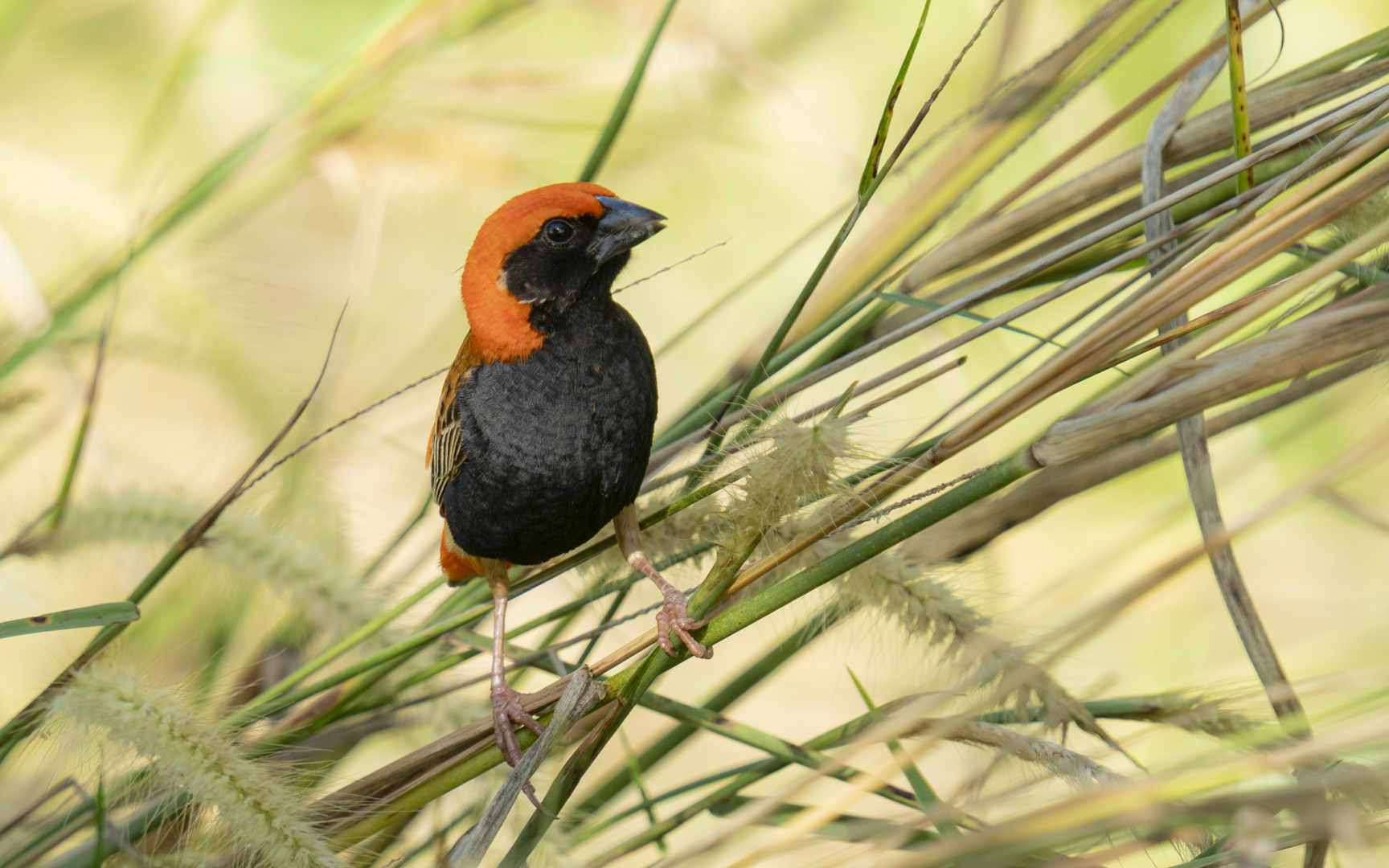
Euplectes nigroventris – ムナグロキンランチョウ
Scientific Name: Halcyon smyrnensisEnglish Name: Zanzibar Red BishopObserved in: Changi Bay PointLocal Status: Uncommon introduced residentObserved Timing: May-24 チャンギ空港の北に恐ろしくアクセスの悪いポイントがあり、遊歩道に沿って多い茂る藪の中には様々な外来種が暮らしています。当種は写真で見るよりも意外に大きく、炎天下の中、オレンジ色をぎらつかせていました。この特徴的な色は繁殖期のオス特有のものであり、メス及び非繁殖期のオスは地味な色をしています(写真左下)。 元々の生息域はザンジバル島を含むタンザニア東部です。
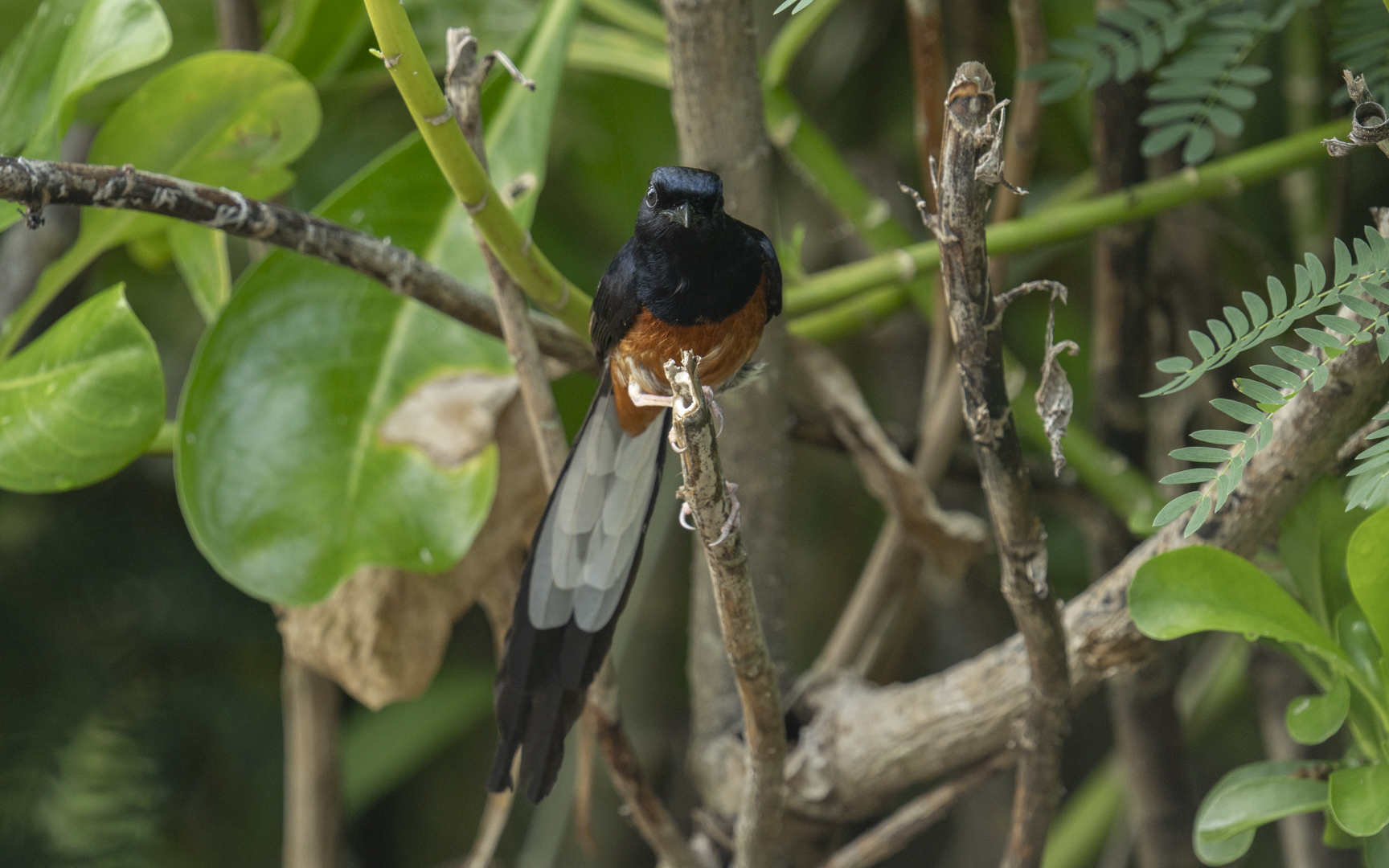
Copsychus malabaricus – アカハラシキチョウ
Scientific Name: Copsychus malabaricusEnglish Name: White-rumped shamaObserved in: Pulau Ubin, Changi Bay PointLocal Status: Uncommon residentObserved Timing: May-22, May-24 当地にはいくつかの島が存在しているが、定期船の出ている島はさほど多くない。その一つがPulau Ubinであり、豪快に黒い煙を上げながら進む小型船で10分足らずで到着する。そこではシンガポール本土では見られない希少な鳥たちが観察される。当種はその中では一般的である。本土でよく見られるシキチョウの様な見た目をしているが、長く伸びた尾羽が美しい。完全に設定を誤った撮影してしまったので、撮り直しの機会を伺っている。 (追記) Changi Bay Pointにオレンジ色の外来種を撮りに行ったときにいい感じに現れてくれました。その後、Pulau Ubinを再訪しましたが、声は聞けど姿は見れませんでした。
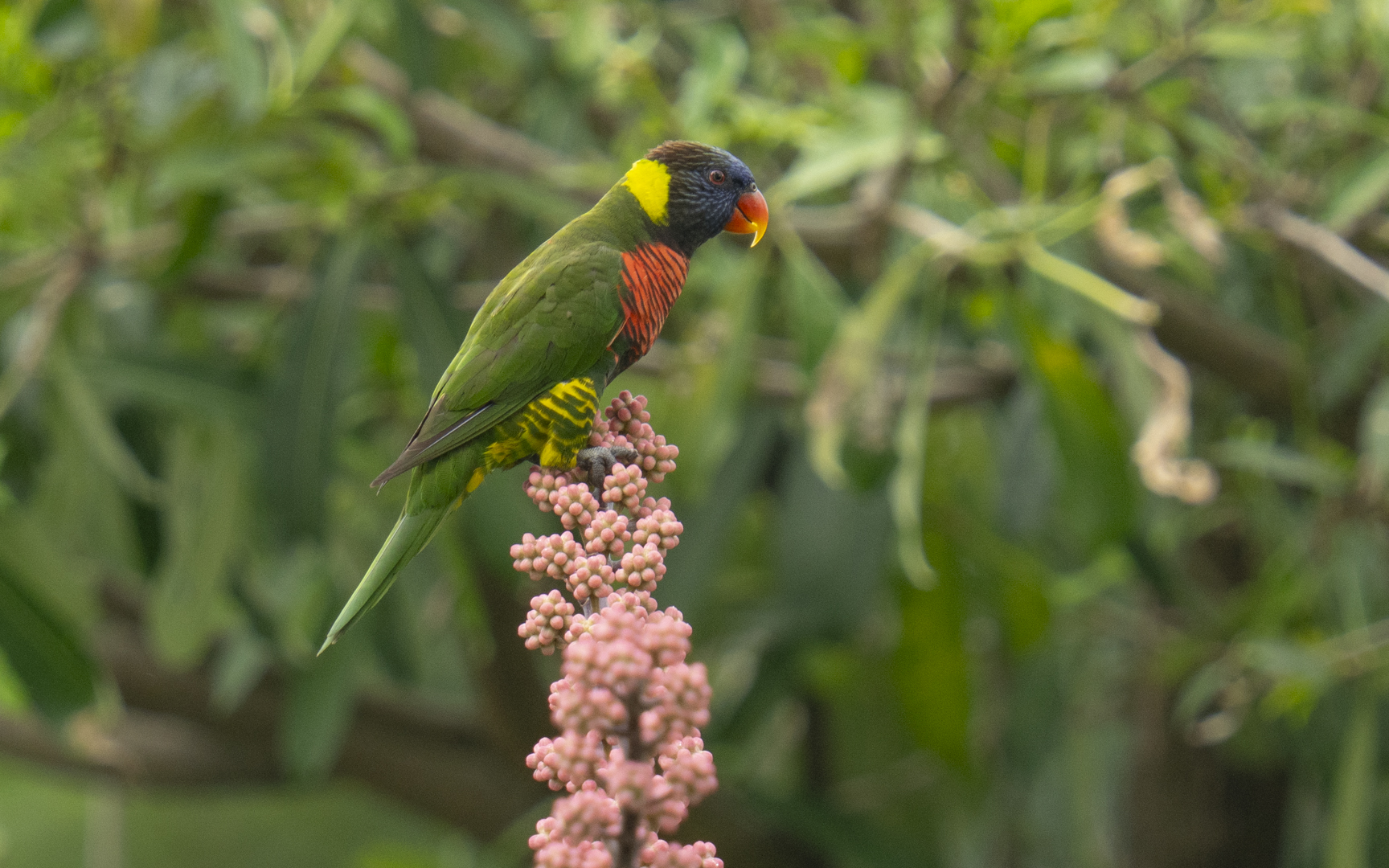
Trichoglossus haematodu – ニューギニアゴシキセイガイインコ
Scientific Name: Trichoglossus haematoduEnglish Name: Coconut LorikeetObserved in: Ghim MohLocal Status: Uncommon introduced residentObserved Timing: Apr-24 Ghim MohのHDBのそばでムネアカゴシキドリが子育てをしていたそのすぐそばで、Umbrella Tree (Heptapleurum actinophyllum)をつつきに頻繁に現れていました。 当種はもともとゴシキセイガイインコ (Rainbow Lorikeet)と呼ばれていましたが、それがTrichoglossus moluccanusに別種記載されたために、ニューギニアゴシキセイガイインコとなりました。ちなみに、Umbrella Treeの原産地もニューギニア地方のようです。
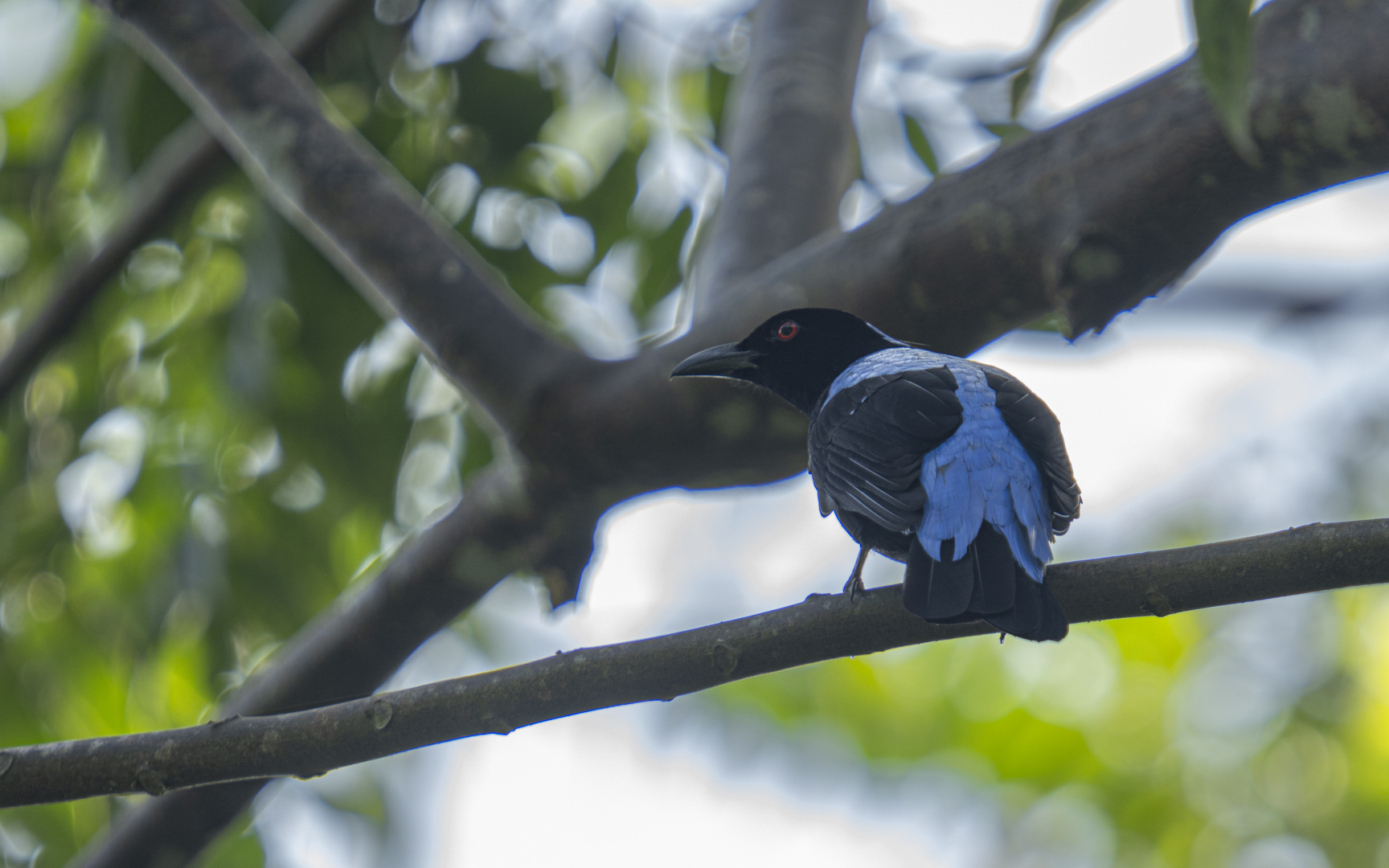
Irena puella – ルリコノハドリ
Scientific Name: Irena puellaEnglish Name: Asian Fairy-bluebirdObserved in: Dairy Firm Nature ParkLocal Status: Uncommon residentObserved Timing: Feb-22 Dairy FirmのWallace Trailの周辺やHindedhe、Buki Timahに生息しており、場所の特定はできているのですが、シャイな性格でなかなか姿を現してくれず、手こずっています。もう少しいい写真を2024年に撮ったはずなのですが、見当たりません。。。消してしまったのだろうか。撮り直してきます。
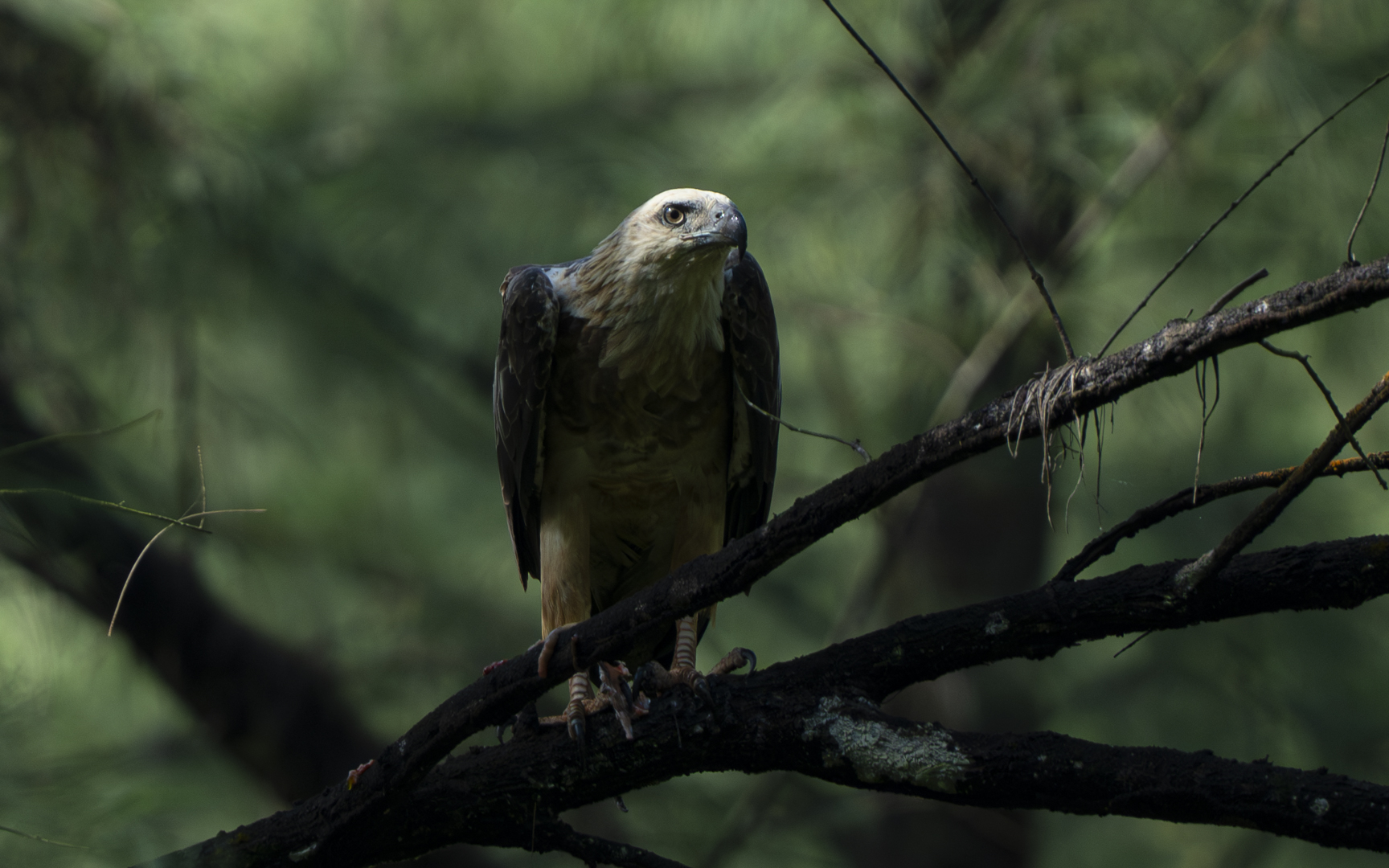
Pernis ptilorhynchus – ハチクマ
Scientific Name: Pernis ptilorhynchusEnglish Name: Crested Honey BuzzardObserved in: Lorong Halus, Coney IslandLocal Status: Common MigrantObserved Timing: Jan-22, Nov-24 渡りの時期に猛禽が上空を飛んでいれば当種の可能性が高いでしょう。大型の猛禽が大空を滑空していく姿は目を引きます。東洋区の全域及び、日本やロシア南部を含む地域に生息しています。
